Moira Butterfield's Blog, page 27
March 25, 2019
Behind the Scenes of a Picture Book Character by Chitra Soundar
A typical conversation I have with teachers at schools:
Teacher: How do you choose an illustrator?Me: I don’t. Publishers choose.Teacher: Do you get to tell them how to illustrate?Me: Nope!
Most often, especially when a writer is starting out, they don’t get to choose an illustrator or give stage directions or write illustrator notes into manuscripts. At least that has been my experience on the 20 picture books I’ve published so far and with the next few coming out soon.
I recently was part of a twitter conversation where some people said their stories appear as words in their mind. But for me it’s scenes, visuals, characters who appear and talk. When I write, I visualise the story in my head.
So when I get to see my story fully illustrated, it will be nowhere near what I’ve imagined for the following reasons:
a) The illustrator has a different mind. Their experiences have created a vision in their minds.
b) A picture book has inputs from many experts. The words of the story is the north star, but those words can still be interpreted differently by the editor, the designer and the illustrator.
c) It is a multi-creative process. When a story has been written, it then transforms into pictures in an independent creative process and that varies from illustrator to illustrator, just like no two writers will write the same story in the same way.
More recently I’ve been more interested in thinking about how characters are formed. When I wrote the first story for Farmer Falgu, I didn’t have a specific farmer in mind. From the name, it might have been obvious to an Indian reader that he might be north Indian (as there is a river called Falgu in the north) and in the south, the names are more Dravidian and we don’t have the consonant F in our languages.
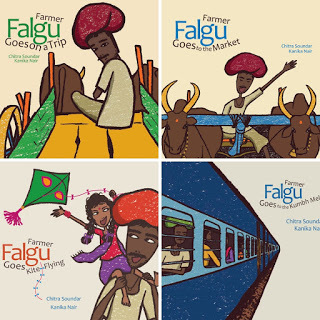
But Kanika Nair who illustrated the first book and the series of 4 titles, had grown up in Rajasthan. So she brought her life experience to the story and made him a farmer from Rajasthan. This was not in my text and something I had not imagined. Read her interview here.
She said, "Farmer Falgu Series has been one of my favourites. While reading the script for illustrating I felt an interesting connection between the story and my hometown. Thus, decided to set the story in Rajasthan, a state in northern India that is rich in historical significance and famous for its vibrant colourful culture."
The first two stories for this farmer were already written and now he had a specific personality as created by the illustrator. What does that mean to me as a writer then?
For the third and the fourth book, I decided to embrace this aspect of Farmer Falgu a bit more. So when I was thinking of a plot line for Book 3 (read about how to write a series here), I decided to bring the cultural aspects of Rajasthan into the story – and hence he goes kite flying. Read more about how this story came about here.
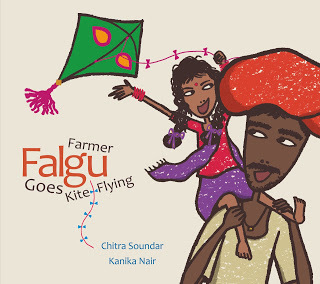
Does this happen to all writers and characters? Does the illustrator bring out a different aspect of the character that the writer hadn’t visualised? I went hunting to find out about some famous characters and their creators.
Here is an interview by Julia Donaldson and Axel Scheffler on creating the Gruffalo and the animals in the forest. Read how Julia had a different colourful image in her mind and when Axel finally settled on how Gruffalo looked, she was happy with it. And then came of course other stories for Gruffalo and Gruffalo’s child and they all had to follow Axel’s portrayal of the forest and the animals.
Another famous collaborator is Quentin Blake and he too talks about how his pictures came to be to bring life to Roald Dahl’s words.
In an interview published here in the Guardian, this is what Quentin Blake says –
"What was so wonderful to me was that so many of Roald's stories were fantastical, unrealistic, so I was free to do what I wanted. I could let my style develop. Think of The Twits or the BFG - they don't really take place in a realistic world. They come from my head."
In another interview for the BBC Quentin Blake recalls visiting Dahl and Sophie and redrawing the illustrations for BFG after that.
And that’s a rare thing indeed because after 20 picture books, I’ve had dinner with only two of my illustrators and I haven’t even met most of them.
Whether Blake’s illustrations then in turn influenced Roald Dahl or not when he wrote the next story, I don’t know. But as children and adults who read these books, the characters like Matilda, BFG and the Twits are visualised in our heads are from Blake’s illustrations. Aren't they?
Do you write picture books? What are your experiences working with an illustrator? Share below in comments. Are you an illustrator? How do you go about making up a character from someone else's words?
 Chitra Soundar is an Indian-born British writer, storyteller and internationally published author of children’s books, based in London, England. Chitra writes picture books, poetry and fiction for children and often visits schools, festivals and libraries to run writing workshops and tell stories. Find out more at www.chitrasoundar.com.
Chitra Soundar is an Indian-born British writer, storyteller and internationally published author of children’s books, based in London, England. Chitra writes picture books, poetry and fiction for children and often visits schools, festivals and libraries to run writing workshops and tell stories. Find out more at www.chitrasoundar.com. Follow her on Twitter @csoundar.
Published on March 25, 2019 00:00
March 18, 2019
This Blog Post Is Gay - Garry Parsons
The title of this post is respectfully borrowed and adjusted from Juno Dawson’s witty and frank manual “This Book Is Gay” first published in 2014, an important book for anyone to read, not just the LGBT* community. This book is not only informative, it is wholly accepting and basically gives the message that, whoever you are or whoever you are not, it is ok to be you. And that is a message I couldn’t agree with more and one I would hope to pass to my kids.
 This Book Is Gay by Juno Dawson - Hot Key Books 2014
This Book Is Gay by Juno Dawson - Hot Key Books 2014Apparently, the market for young adult fiction featuring characters identifying as LGBT is growing. Authors like Amy Rose Capetta, Amber Smith, Christina Lauren, Tim Federle and Juno Dawson, who also writes YA fiction, are appreciated by readers who are looking for a broader diversity of protagonists and storylines with positive reflections of who they feel themselves to be.
Representation in books is so important not only for young people who are themselves LGBT, but for everyone finding themselves in a minority community, and also for those who are not, in order to feel empathy and gain understanding.
The recent wave of diverse characters in young adult fiction appears to be slowly making its way as subject matter for picture books. There are and have been books alluding to gay characters or featuring same-sex parents, but, by comparison to the plethora of picture books out there, these are very few and can sometimes be lacking in subtlety or quality. As an illustrator, parent and member of the LGBT community myself, this is an area I feel is overlooked and in need of representation and encouragement.This could all be about to change.In February this year CBeebies’ Bedtime Story featured singer Will Young reading Carolyn Robertson’s picture book “Two Dads”, illustrated by Sophie Humphreys, about a boy who has been adopted and brought up happily by two fathers. This episode was shown to coincide with LGBT History Month.
 Will Young reading Two Dads by Carolyn Roberson illustrated by Sophie Humpreys
Will Young reading Two Dads by Carolyn Roberson illustrated by Sophie Humpreys“Children’s books are one of the first ways we learn about the world around us so I’m overjoyed to be reading a story to mark LGBT History Month,” said Young.
I wholeheartedly agree. Children need to be able to see the world around them, and themselves reflected in it, no matter who they are and picture books have proven to be remarkable vehicles for this. When the subject matter sits on the periphery of our daily lives or the story concerns something we know very little about, picture books are a good way to start a conversation about them for both adults and children. Here are a few stunning picture books that I feel deal with complex issues in clever, subtle and thoughtful ways:The challenges of a refugee family in "The Journey" by Francesca Sanna, tolerance in "Marshall Armstrong is New to Our School" by David Mackintosh, losing a loved one in "Grandad’s Island" by Benji Davies and the dangers of lies skewing reality in "The New Neighbours" by Sarah McIntyre, for example.
 The Journey by Francesca Sanna. Marshall Armstrong Is New To Our School by David Mackintosh. Grandad's Island by Benji Davis and The New Neighbours by Sarah McIntyre
The Journey by Francesca Sanna. Marshall Armstrong Is New To Our School by David Mackintosh. Grandad's Island by Benji Davis and The New Neighbours by Sarah McIntyreSo what about picture books dealing with the difference a child might feel who might later identify as LGBT? Most LGBT adults can recall the sense of being ‘different’ at a very early age. These books were not around when I was six years old, but they are titles I wish I had seen and ones that offer something else.
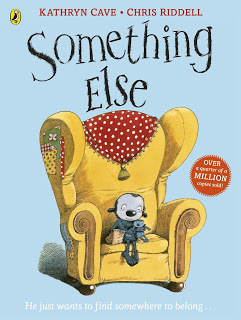 Something Else by Kathryn Cave illustrated by Chris Riddell - Puffin 1994
Something Else by Kathryn Cave illustrated by Chris Riddell - Puffin 1994“Something Else” by Kathryn Cave, illustrated by Chris Riddell, first published in 1994 and boasting over a quarter of a million copies sold, is the story of a creature who is told he does not belong and is unjustly excluded, and also about how you can befriend a person who is finding fitting in difficult.
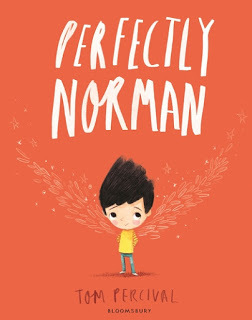 Perfectly Norman by Tom Percival - Bloomsbury 2017
Perfectly Norman by Tom Percival - Bloomsbury 2017"Perfectly Norman" by Tom Percival, published by Bloomsbury in 2017, is about a little boy who realises that being bold enough to embrace being different is what leads to his happiness.
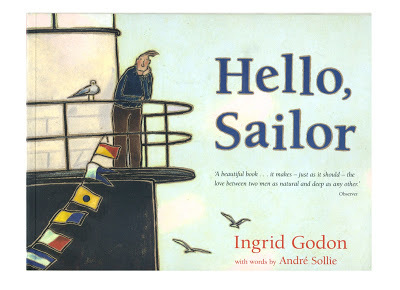 Hello Sailor by Andre Sollie illustrated by Ingrid Godon - Macmillan 2000
Hello Sailor by Andre Sollie illustrated by Ingrid Godon - Macmillan 2000My personal favourite, “Hello Sailor” by Andre Sollie and illustrated by Ingrid Godon, tells the story of Matt, who lives in a lighthouse and spends his time watching the sea for his friend Sailor to return to him. “A beautiful book…it makes – just as it should – the love between two men as natural and as deep as any other,” says the Observer.
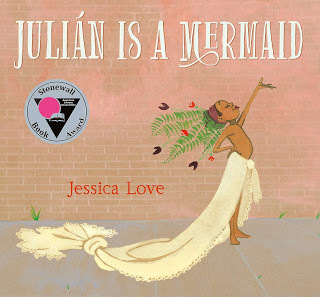 Julian Is A Mermaid - Jessica Love - Walker Books 2018
Julian Is A Mermaid - Jessica Love - Walker Books 2018"Julian Is A Mermaid" by Jessica Love, published in 2018 to high acclaim, The Sunday Times calling it “celebratory and ground-breaking”, is the story of a little boy who is mesmerized by the sight of three women in flamboyant dresses he sees while travelling on the subway with his Nana. He leads us, unashamedly, on a journey towards love and acceptance. Who wouldn’t want this freedom of expression for children?
 Interior illustration from Julian Is A Mermaid - Jessica Love
Interior illustration from Julian Is A Mermaid - Jessica Love Whilst these four books don’t explicitly speak about same-sex relationships, gender stereotypes or being LGBT, the themes of feeling different, the need for acceptance and the exploration of self-identity can be appreciated without them being preachy.
This is what Tom Percival says about Perfectly Norman :“the wings are symbolic—of freedom—once you allow yourself to be open and honest about who you really are, you can fly free.”
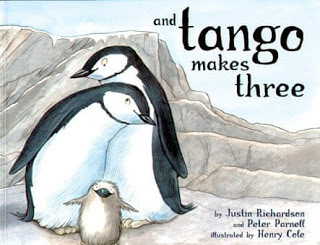 And Tango Makes Three by Justin Richardson & Peter Parnell illustrated by Henry Cole - Simon & Schuster 2007
And Tango Makes Three by Justin Richardson & Peter Parnell illustrated by Henry Cole - Simon & Schuster 2007And then there is the popular, and at the same time controversially unpopular, “And Tango Makes Three” by Justin Richardson & Peter Parnell and illustrated by Henry Cole.“And Tango Makes Three” tells the story of two male penguins, Roy and Silo, who create a family together, based on the true story of two male penguins that hatched an egg in the New York City Zoo.
 Roy and Silo's adopted egg hatches - from And Tango Makes Three - illustrated by Henry Cole
Roy and Silo's adopted egg hatches - from And Tango Makes Three - illustrated by Henry ColeThe story explores the universal way families form around love and shows that some families who can't have children of their own adopt, in this case with the help of the zookeeper, Mr. Gramsay, who gives them an extra egg from another penguin couple at the zoo.“And Tango Makes Three” has been at the centre of many censorship debates on same-sex marriage, adoption, and homosexuality in animals and periodically banned in public libraries in certain states in America. In Singapore, the National Library Board were persuaded to file the book in the adult section. At the same time “And Tango Makes Three” has been used in schools as a teaching aid and has won multiple awards, including being on The American Library Association’s Notable Children's Book list in 2006.
Undoubtedly, picture books can be powerful starting points for provoking thought, leading to empathy or letting the reader know that “It’s ok to be me”.
I know I would have enjoyed and valued the story of "Julian Is A Mermaid" when I was six and I certainly would have benefitted from the frankness of Juno Dawson’s "This Book Is Gay" as a young adult.
 Illustration by Spike Gerrell from This Book Is Gay by Juno Dawson
Illustration by Spike Gerrell from This Book Is Gay by Juno DawsonFor me, these books give hope, especially in a time when the world is struggling to tackle discrimination and hatred in all its myriad forms. We need to be able to give our children a moment where they can feel confident and safe to explore the people they feel themselves to be, whatever that might be, whoever and whatever they grow up to be, even if it is to be a mermaid.
Garry is proud to have recently been asked to illustrate a picture book with an “It’s ok to be you” theme and which was the prompt for this post.
* LGBT - lesbian, gay, bisexual and transgender.
Published on March 18, 2019 00:52
March 11, 2019
Fun with words!- a picture book word search - Lucy Rowland
I recently went on a vocabulary teaching course, where the presenters talked about the importance of playing word games and having 'fun with words'. Whilst the course was really about strategies to teach vocabulary to children, it made me think that, as adults, we still really enjoy word games. 'Taboo', 'Articulate', 'Scrabble' and 'Balderdash' are all firm family favourites in our house at Christmas. So, just for fun, I decided to create a word search filled with (you guessed it) picture book titles!
Can you find the 11 picture book titles listed below the puzzle? Good luck! (It took me quite a while! )

BLOWN AWAYDOGGEREDIEFARMER DUCKGRANDAD'S ISLANDLOST AND FOUNDMR WOLF'S PANCAKESOI FROG!ROOM ON A BROOMTHE GRUFFALOTHE JOLLY POSTMAN
Lucy's next picture book, illustrated by the fantastic Paula Metcalf, will be published on 4th April.You won't find it in the word search but keep an eye out for on the shelves!
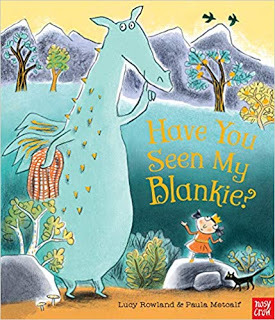
Published on March 11, 2019 00:00
March 3, 2019
Q & A with Steven Salerno: The Process of Illustrating Creative Non-Fiction Picture Books
When my editor, Ann Rider, first suggested Steven Salerno to illustrate THE CRAYON MAN: THE TRUE STORY OF THE INVENTION OF CRAYOLA CRAYONS, I was fascinated to read some of his blog posts about the making of his books. I asked him about the similarities and differences between illustrating non-fiction and fiction picture books:
When an editor first approached you about doing your first non-fiction picture book project, what were your thoughts about taking it on?
I started illustrating picture books in 2000, and by 2011 had already illustrated 17 popular fiction picture books, and with all of them in a decidedly whimsical style. So in 2011 when an editor at Houghton Mifflin Harcourt asked me to illustrate Brothers at Bat (a non-fiction true story about 12 brothers who formed their own professional baseball team and played from the late 1930’s until the early 1950’s) my initial reaction was that of surprise . . . simply because up until that point none of my fiction picture books stylistically suggested that I was the perfect choice to illustrate a non-fiction story that logically would be best illustrated in a more realistic style in order to capture the look and feel of the 1930’s through the 1950’s.
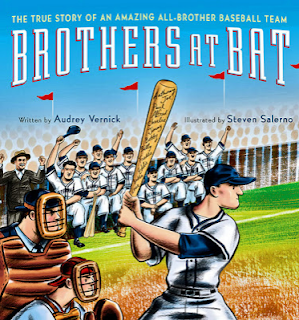 Brothers At Bat by Audrey Venick & Steven SalernoI myself knew that I could indeed create wonderful, appropriate illustrations for the story, because drawing in a more realistic manner is not a difficulty at all, but I was curious why the editor took that stylistic leap of faith in me!
Brothers At Bat by Audrey Venick & Steven SalernoI myself knew that I could indeed create wonderful, appropriate illustrations for the story, because drawing in a more realistic manner is not a difficulty at all, but I was curious why the editor took that stylistic leap of faith in me!How is it different illustrating fiction vs non-fiction?
A really significant difference is in the researchphase . . . For example: In one of the fiction picture book stories I illustrated, BOOM! – about a dog named Rosie who is afraid of thunder, and his owner who comforts her – it happens to mention a firetruck and an orangutan . . . So my research for that book merely involved looking at maybe 50 potential reference photos and narrowing them down to the 2 or 3 photos that I actually used as specific reference. Every other visual element created within the illustrations for BOOM! was drawn out of my imagination without any need for reference whatsoever. And all of the other fiction picture books I’ve illustrated also required extremely minimal reference photo research.
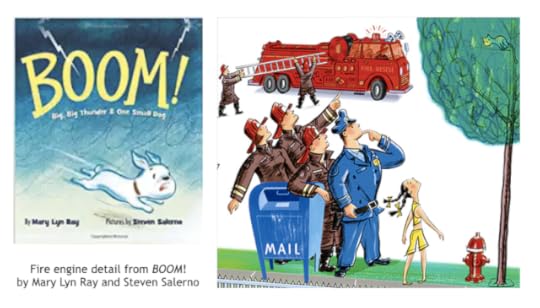 At the opposite end of the research spectrum is the amount of research that goes into a non-fiction, historical picture book story. For the seven non-fiction picture book stories that I have illustrated thus far, on average, I probably scour through about 3,000 potential historic/period reference photos in order to narrow them down to the 100 to 150 photos that I actually end up using as specific reference to create the sketches and final illustrations for the non-fiction picture book.
At the opposite end of the research spectrum is the amount of research that goes into a non-fiction, historical picture book story. For the seven non-fiction picture book stories that I have illustrated thus far, on average, I probably scour through about 3,000 potential historic/period reference photos in order to narrow them down to the 100 to 150 photos that I actually end up using as specific reference to create the sketches and final illustrations for the non-fiction picture book. 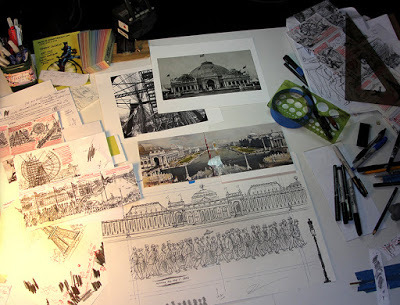 Steven Salerno's desk whilst working on The Fantastic Ferris Wheel
Steven Salerno's desk whilst working on The Fantastic Ferris Wheel by Betsy Harvey Kraft. Note the reference photographs!
Another significant difference is TIME! – a lot more time! – because of the added time involved with the research phase, and also the significant additional time it takes to create the sketches and final illustrations, which all must reflect real people and places, correct fashions and other objects that are correctly rendered to reflect a specific time period. This is a much slower process!
The net result is that creating the sketches and illustrations for a non-fiction picture book, on average, takes me about eight months total, whereas the fiction picture books that I have illustrated, on average, take me about five and a half months in total.
You start each picture book project – fiction OR non-fiction – by reading the story many times and then doodling ideas in the margin of the manuscript. Can you elaborate a bit more about this process and its importance in capturing the story
and its voice?
Creating these very tiny, visual shorthand rough sketches directly into the margins as I read the story is simply so that I can immediately begin formulating a record of my initial instinctive vision for the illustrations nearly as fast as I generate the visual compositional concepts in my head.



How long did it take you to research reference for your new book THE CRAYON MAN: THE TRUE STORY OF THE INVENTION OF CRAYOLA CRAYONS by Natascha Biebow?
It probably took about a month to sort through the roughy 3,000 potential reference photos and narrow them down to the 100 to 150 that ended up actually being used as specific reference to complete the sketches, refined sketches and final illustrations.
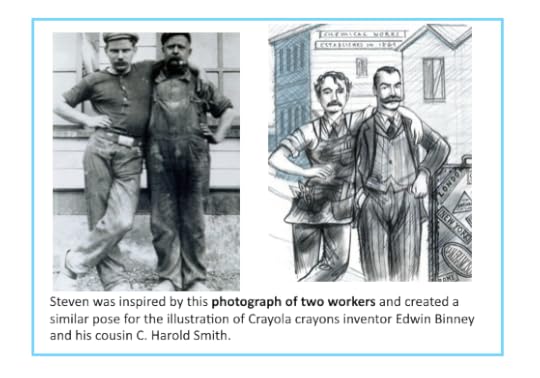
 Where do you find your reference?
Where do you find your reference?The author sometimes provides useful reference materials. In addition, some of the reference photos I located were in books, but the vast majority came from on-line searches. This yields many photos, unfortunately, but most of them are very small, and of low pixel resolution. So many times you will find a pertinent photo on screen, but because of its size/resolution limitations, it is totally useless as photo reference that you can actually print out and physically use as a photo alongside your sketch that you can easily refer to. So online not only do you have to locate a pertinent reference photo, but it also must be of a certain size and resolution enabling it to be physically printed out.

What do you do when you can’t find accurate visual reference for a particular element in the manuscript given that it’s meant to be a true story?
This happens a lot! For example, with The Crayon Man, the main character is Edwin Binney, who was, in the story's timeline, about 35 to 38 years old. But the only reference photos of the actual real person that I could find of him were when he was about 57 to 65 years old.So, to create the illustrations, I had to imagine what Edwin looked like at 35 - 38 years old based on the available photos of him.
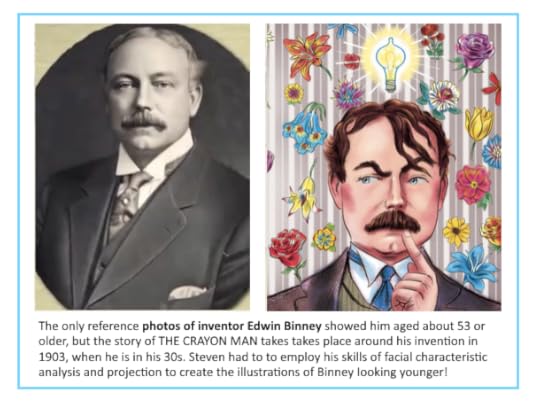
In another example: when I created the illustrations I created for The Fantastic Ferris Wheel, the true story about the making of the first gigantic observation wheel (Ferris wheel) for the 1893 World’s Fair in Chicago. I ran into the following problem: At that time the tallest building in America was only about 30 stories tall . . . and the Ferris wheel was about 27 stories tall . . . which meant that any reference photos I could locate of the Ferris wheel from 1893 were all from an angle looking UP at the wheel.
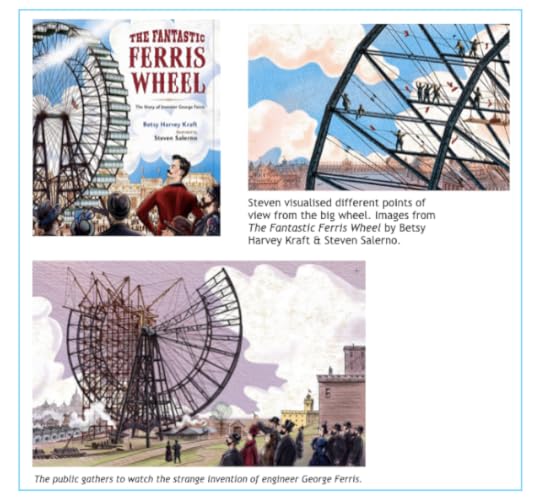 But in my initial sketches I envisioned many scenes that were looking at an angle DOWN at the Ferris wheel. This meant that I had to understand how the wheel was constructed so that could devise angles looking down at the wheel in my drawings . . . which was not easy to do!
But in my initial sketches I envisioned many scenes that were looking at an angle DOWN at the Ferris wheel. This meant that I had to understand how the wheel was constructed so that could devise angles looking down at the wheel in my drawings . . . which was not easy to do!
Can you give some examples of when you completely re-thought an illustration or composition as a result of something you discovered in your research or some feedback you received from the creative team?
Before I do any photo reference research myself, I create my initial rough sketches for the book based solely on the events and actions as specifically described by the text, first in a very rough storyboard format. So once I have already determined my intended images for all the inside of the book illustrations via these rough storyboard images, I then do my reference research to specifically support the elements within the sketches. So I have never located a reference photo that completely changed my intentions for the illustrations. Once I complete all my refined final sketches and they are presented to the publisher (to the editor, art director and designer) they offer their comments and suggestions to improve upon the imagery relative to their communication of the story. Usually all of the sketches are essentially approved as is, with only relatively minor tweaks suggested to improve upon their clarity. But their very smart suggestions, though seemingly minor, really do help to make the illustrations truly be their best.
Let’s look at covers. What do you think makes for a dynamic and commercial cover? How do you make non-fiction relevant so it grabs contemporary readers?
I always feel that any cover, whether for a fiction or non-fiction picture book should essentially be simple, regardless of whether the illustrator’s style is complex or minimalist or anywhere in-between. It should be an evocative, simple, poster-like image that only needs to reflect the core theme or mood of the story, even if in just a conceptually suggestive manner.
 The basic goal should be to create a visually teasing gem that has the viewer wanting to open the book and look inside . . . What a cover does not have to be, nor should be, is a complex/busy visual scene or concept that overly explains the inside of the book.
The basic goal should be to create a visually teasing gem that has the viewer wanting to open the book and look inside . . . What a cover does not have to be, nor should be, is a complex/busy visual scene or concept that overly explains the inside of the book. 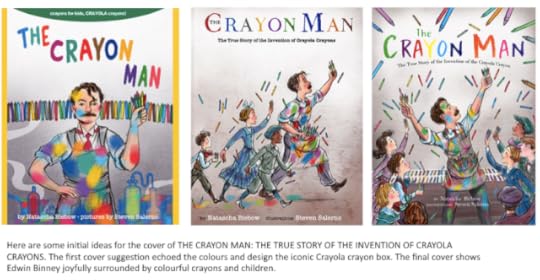
In my opinion it's ultimately always a much more effective marketing tactic in terms of sales for the cover to just be very simple and striking rather than get caught up in trying to have too many explanatory elements.
What is your top tip for illustrators who are considering trying their hand at non-fiction picture book illustration?
When I illustrate a non-fiction picture book, I personally take the visual stylistic approach of creating the illustrations in a more realistic manner compared to the more stylized whimsical approach I take with the many fiction picture books I have illustrated. But this does not mean that a non-fiction story MUST be illustrated in a realistic manner. A non-fiction story can be wonderfully illustrated in any manner of illustrative style . . . so the only tip I can offer is simply ensure the illustrations capture the spirit of the real people and events described in the story.
Edwin Binney's inspirational story, THE CRAYON MAN: THE TRUE STORY OF THE INVENTION OF CRAYOLA CRAYONS, will be published in March 2019.
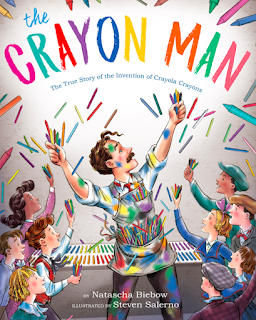 View the trailer!
View the trailer!Steven Salerno’sfavourite crayon colour is ALL OF THEM, because sometimes each one is the perfect choice. He lives in New York City and creates illustrations for books, magazines, newspapers, advertising, posters, and product packaging. So far he’s illustrated 30 picture books, with five of the titles as both the author & the illustrator. Find him at www.stevensalerno.com
Natascha Biebow's favourite crayon colour is periwinkle blue, because it makes her heart sing. Author, editor, coach and mentor, find her at www.nataschabiebow.com and www.bluelephantstoryshaping.com
Published on March 03, 2019 20:00
February 24, 2019
The Beauty of Burningham, by Pippa Goodhart
I began writing something pontificatious about the wonderful writing and pictures done by John Burningham. But then I thought that, actually, the main point of what I wanted to make was that through the best picture books young children get to meet and know intimately some really top class artwork. Most will probably never look so closely, and think about so deeply, any artwork ever again in their lives. So, to illustrate that point of beauty in books for young children, I've had fun picking out some of my favourite images from books by John Burningham, and I'm now going to shut up and let them speak for themselves ...



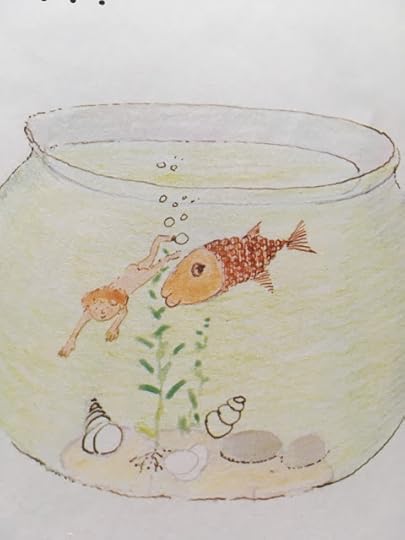
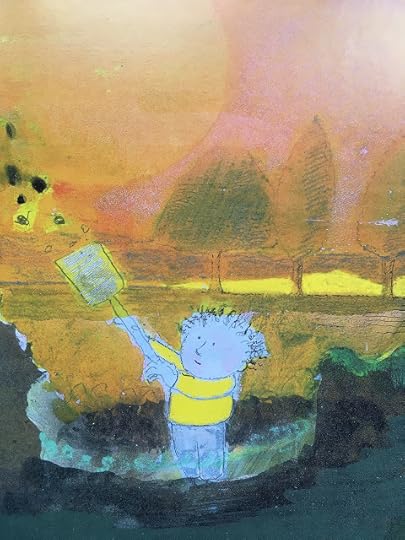



Already much missed, John Burningham 1936-2019
Published on February 24, 2019 16:30
February 17, 2019
My Quest for a Contract • Lynne Garner
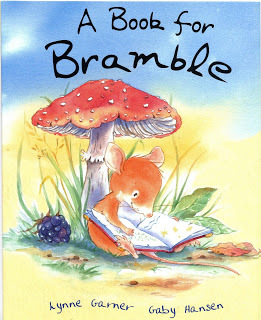 My first picture bookMy first picture book was published way back in 2007. I was lucky, it was my second submission to a picture book publisher. My first submission was rejected but the rejection letter they sent was the nicest I’ve received in the twenty odd years I’ve been writing. Although the editor didn’t like my story, she liked my writing style and ‘voice’ and asked if I had any other stories. I didn’t but I had an idea I’d been working on. After tweaking, adjusting and tinkering with it I sent it off. A few weeks later I received further positive feedback and although I had to rewrite the story six times ‘A Book for Bramble’ was eventually published.
My first picture bookMy first picture book was published way back in 2007. I was lucky, it was my second submission to a picture book publisher. My first submission was rejected but the rejection letter they sent was the nicest I’ve received in the twenty odd years I’ve been writing. Although the editor didn’t like my story, she liked my writing style and ‘voice’ and asked if I had any other stories. I didn’t but I had an idea I’d been working on. After tweaking, adjusting and tinkering with it I sent it off. A few weeks later I received further positive feedback and although I had to rewrite the story six times ‘A Book for Bramble’ was eventually published.Over the next few years the same publisher took a further three stories. During that period my editor moved on and the publisher was sold and purchased several times. This meant I no longer had direct access and have re-joined the thousands of picture book writers fighting for attention in a very competitive market. For a couple of years, I sent out the odd story here and there whilst I concentrated on my collection of short stories. But last year I decided it was going to be ‘my’ year and I was going to get a picture book contract. My plan had two parts to it.
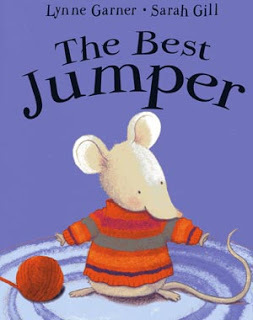 My second picture book
My second picture bookPart one:I decided I’d invest in my writing. I chose my five favourite stories and sent them to the Hilary Johnson Authors’ Advisory Service. Each story was reviewed and sent back with positive feedback and helpful advice. I reworked three of the stories and sent them back for a second review. A further tweak here and there and I had three stories that were the best I could possibly make them. Then came the research and submitting process and over a 12-month period each story was sent out to at least 13 publishers.
Part two:Whilst I waited (and there is a lot of waiting - often months), I researched agents and submitted to 11 agents.
Sadly, all that work, and finger crossing came to nothing. I either didn't receive a response (not unusual) or received the 'thanks but no thanks' rejection.
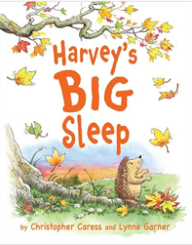 My last picture book but first collaborationAt the beginning of this year I began to wonder if I should forget it. Perhaps I’d had my time. Maybe my best is no longer good enough. However, I love writing picture books. I have a library of stories that with a little help I could improve. I have a stock of ideas screaming to be written down. So, I’ve decided I’m going to give it another go and repeat the process. With fingers crossed I have a little more luck this year.
My last picture book but first collaborationAt the beginning of this year I began to wonder if I should forget it. Perhaps I’d had my time. Maybe my best is no longer good enough. However, I love writing picture books. I have a library of stories that with a little help I could improve. I have a stock of ideas screaming to be written down. So, I’ve decided I’m going to give it another go and repeat the process. With fingers crossed I have a little more luck this year.P.S.If you’re an agent or editor looking for a writer with a proven track record and a passion for picture books please contact me. I have three stories looking for a new home.
P.P.S.Picture book writers - I’d like to know your experiences. Is it me or is it that much harder than it was a decade or so ago?
Thanks
Lynne
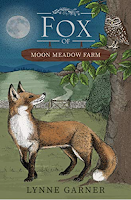
Now for a blatant plug - my collections of short stories (available as ebooks and paperback):
Fox of Moon Meadow Farm (ebook 99p/99¢ - 10 stories)
Hedgehog of Moon Meadow Farm (ebook 99p/99¢ - 10 stories)
Ten Tales of Brer Rabbit (ebook 99p/99¢ - 10 stories)
Ten Tales of Coyote (ebook 99p/99¢ - 10 stories)
Anansi The Trickster Spider (ebook £1.49/$1.49 - 16 stories)
Published on February 17, 2019 22:00
February 11, 2019
Illustrating Water in Children's Picture Books • Paeony Lewis
I adore staring out at the sea, but at this time of year in Norfolk (England) it's too cold to look for long at a grey North Sea (the lumps on the beach are seals, not afraid to bask in the frigid wind). So inside my warm home, I thought it would be intriguing to look at a few illustrations of sea and water in children's picture books, especially as I want to try illustrating the sea.
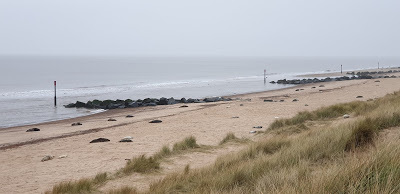
Looking harder at illustrations is always fun (in my opinion!), although sometimes I am stumped at how the artwork was created. For the first image, I'd never have known if the information hadn't been inside the book.
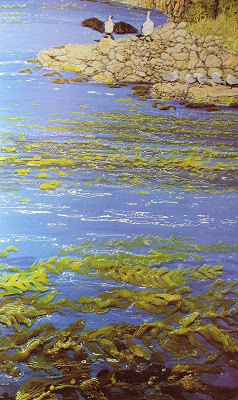 Excerpt from The Hidden Forest by Australian author and illustrator,
Excerpt from The Hidden Forest by Australian author and illustrator,
Jeannie Baker (UK: Walker Books, 2005)
The kelp was modelled with translucent artist's clay and the seawater is resin.
In The Hidden Forest I assume the lighting used in the photography mimics the natural reflection of light? However, sometimes simple paint can have the same impact, as seen below in Town is by the Sea.
 From Town is by the Sea by Joanne Schwartz, illustrated by Sydney Smith (UK: Walker Books, 2018)
From Town is by the Sea by Joanne Schwartz, illustrated by Sydney Smith (UK: Walker Books, 2018)
This is the bright, blinding, shimmering sea.
Throughout the book there are many gorgeous, deceptively simple, atmospheric renderings of the sea.It can be easy to forget how much artistic effort goes into good picture books. I discovered a video where illustrator, Sydney Smith, ponders the illustration of this award-winning book and I thought some of you would be interested in the detail, so here goes…
From childhood, Sydney was familiar with the coast and for the book he visited the mining town of Glace Bay on the eastern tip of Nova Scotia, Canada, to “feel the size of the sea”. He viewed exhibitions too and for the water he absorbed the expressive brushwork of Turner, and the French Impressionists.
 From Town is by the Sea, another illustration of the sea by Sydney Smith.
From Town is by the Sea, another illustration of the sea by Sydney Smith.
The quiet sea.Sidney’s principal tip on painting the sea is to decide on the type of sea. In the book there is the bright, blinding, shimmering sea, a choppy sea, a quiet sea, and a dark sea. Then Sidney suggests becoming the motion of the sea with your brush, “dance with your brush,” and don’t worry about detail because the sea is always moving. Be expressive.
Traditional watercolour is used for Town is by the Sea, along with Pentel brush pens and gouache paint (akin to watercolour mixed with chalk) used dry for the white frothy tips of the waves and the light. Sidney paints multiple versions of the sea double-page spreads, and then he keeps the one that seems to be going best. I suspect this is because although a lot of advance planning is needed, the watercolour is fluid and fast-drying, and so much depends on the specific brushstrokes.
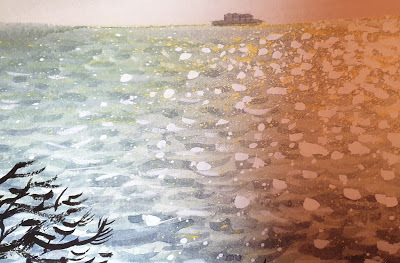 Here is detail from the bright, shimmering illustration by Sydney Smith.
Here is detail from the bright, shimmering illustration by Sydney Smith.
You can see the individual expressive brushstrokes
and the white gouache applied over the watercolour. The next book, also an award winner, amazed me as it was all done with simple crayon and this gives it a contemporary retro look (you know what I mean!). If you saw my feeble efforts with coloured crayons, you'd understand my admiration. It's the narrative non-fiction children's picture book, Shakleton's Journey by young artist, William Grill. Here the white froth of the wave crests and light is simply white, uncrayoned paper.
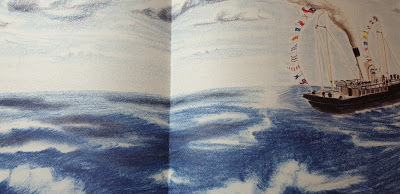 From Shakleton's Journey by William Grill (UK: Flying Eye Books, 2014)
From Shakleton's Journey by William Grill (UK: Flying Eye Books, 2014)
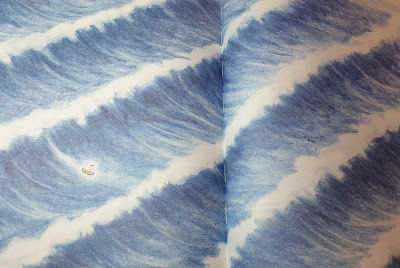 More from Shakleton's Journey by William Grill
More from Shakleton's Journey by William Grill
Churning, great waves, and we know they are enormous from the size of the boat..If you linger and stare at the illustration above, you'll see how there is 'simply' white blank paper separating blue directional lines of crayoned blue, but it's really effective. In an interview William says, “I try to work as loosely as I would in a sketch book… I’ll do it again and again until I’ve got it right, so it looks like I’ve just sketched it quickly.”
Even if you are a world-renowned illustrator, sometimes you discover an Achilles heel, and drawing churning water flummoxed French-born artist, Tomi Ungerer. In a video Tomi talks about Fog Island (then called Fog Man), and near the end discusses his path to solving the problem of the waves.
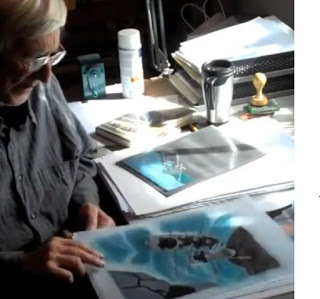 Tomi Ungerer, talking about Fog Island.
Tomi Ungerer, talking about Fog Island.
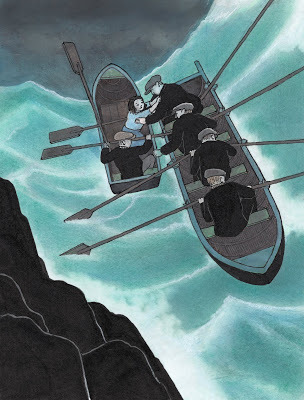 From Fog Island by Tomi Ungerer (UK: Phaidon Press, 2013)Tomi explains how all his life (born 1931) he had a hard time drawing waves, despite during his later life living by the sea in Nova Scotia, and then on an Irish island. It was with the above illustration for Fog Island that Tomi developed a new technique. When he first attempted the waves Tomi was inspired by Hokusai's wave, but he was told his interpretation lacked movement and looked frozen.
From Fog Island by Tomi Ungerer (UK: Phaidon Press, 2013)Tomi explains how all his life (born 1931) he had a hard time drawing waves, despite during his later life living by the sea in Nova Scotia, and then on an Irish island. It was with the above illustration for Fog Island that Tomi developed a new technique. When he first attempted the waves Tomi was inspired by Hokusai's wave, but he was told his interpretation lacked movement and looked frozen.
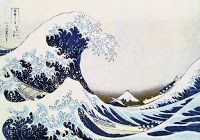 Hokusai's waveSo Tomi Ungerer persevered and developed another technique. You might be able to see in the video image that Tomi uses semi-translucent tracing paper and he explains how green pastel was applied to the back of the transfer paper and pencil and gouache to the front, with extra, darker pastel where necessary. I was a little confused with the explanation, but that doesn't matter because what is inspiring is that an acclaimed artist experimented until the problem was solved, even though he was in his eighties. It was the same with the fog; Tomi assumed covering the drawing with light grey pastel would give the effect of fog, but discovered it wasn't that simple because real fog plays with perspective and he adapted that technique too.
Hokusai's waveSo Tomi Ungerer persevered and developed another technique. You might be able to see in the video image that Tomi uses semi-translucent tracing paper and he explains how green pastel was applied to the back of the transfer paper and pencil and gouache to the front, with extra, darker pastel where necessary. I was a little confused with the explanation, but that doesn't matter because what is inspiring is that an acclaimed artist experimented until the problem was solved, even though he was in his eighties. It was the same with the fog; Tomi assumed covering the drawing with light grey pastel would give the effect of fog, but discovered it wasn't that simple because real fog plays with perspective and he adapted that technique too.
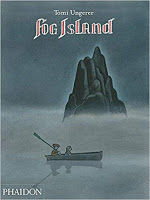
Poignantly, whilst researching Tomi Ungerer, I discovered this maverick, acclaimed artist had died the day before, aged 87 years. My heart lurched.
Another acclaimed, award-winning artist, Leo Lionni (also now departed), used a very different technique for water. I've only just discovered Swimmy by Leo Lionni, and it is now a new favourite, despite being first published in 1963. I first heard of this book through reading Eric Cale and Lane Smith praising the book and it has been recently reissued in the UK. Leo was an artist/graphic designer who didn't start producing children's books until his fifties.
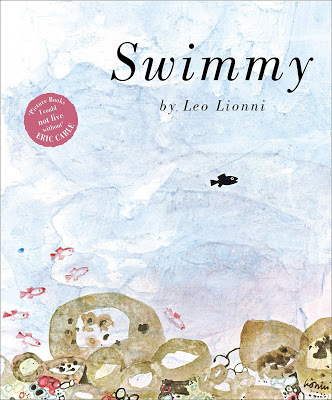 Swimmy by Leo Lionni (UK: Andersen Press, 2015)
Swimmy by Leo Lionni (UK: Andersen Press, 2015)
The cover is shown large so you can see the texture of the water.I gather Leo Lionni used a variety of mediums and for this book he used different stamps and printing, wax resist and plastic wrap (clingfilm) on diluted blue tempera paint. It gives such a feeling of loose, liquid, spontaneity. And the seaweed made me grin: he printed it using the ornamental edge of a napkin or doily. Maybe it is a little messy, but there is an innovative joy to the images and it oozes wetness!
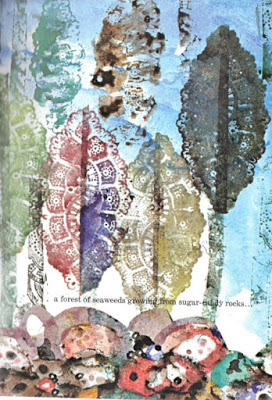 From Swimmy by Leo Lionni
From Swimmy by Leo Lionni
Perhaps some of my enthusiasm for Swimmy comes from the fact I've been experimenting with illustrating water on my course and only a week before seeing this book I'd been playing with watercolour and clingfilm. Snap! OK, I know I'm only a beginner, but as has been seen, all the professional illustrators experiment too.
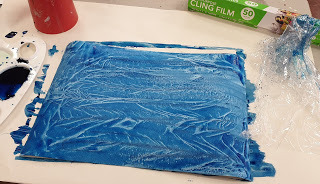
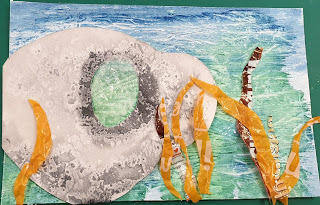 Paeony Lewis, having fun, experimenting.And finally, here are a few more examples of water from different children's picture book illustrators. Can you guess how they were created?
Paeony Lewis, having fun, experimenting.And finally, here are a few more examples of water from different children's picture book illustrators. Can you guess how they were created?
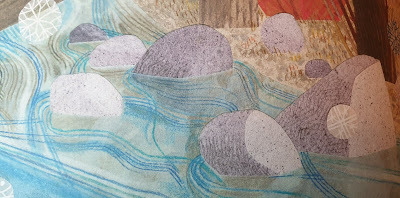 From Bear Hug by Katharine McEwen (UK: Templar, 2014)
From Bear Hug by Katharine McEwen (UK: Templar, 2014)
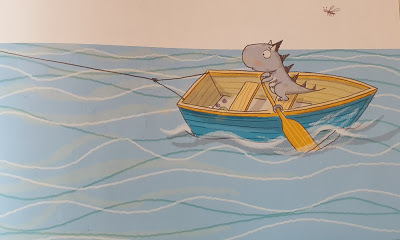 From Roo the Roaring Dinosaur: Best Playday Ever!
From Roo the Roaring Dinosaur: Best Playday Ever!
by David Bedford, illustrated by Mandy Stanley (UK: Simon & Schuster, 2016)
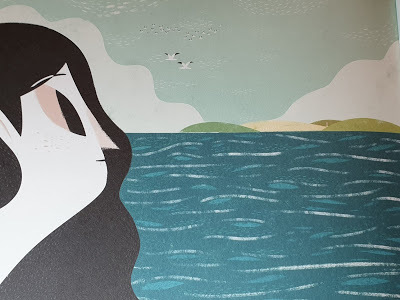 From The Journey by Francesca Sanna (UK: Flying Eye Books, 2016)
From The Journey by Francesca Sanna (UK: Flying Eye Books, 2016)
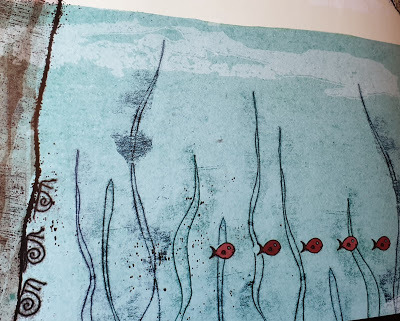 From The Crocodile Who Didn't Like Water by Gemma Merino (UK: Macmillan, 2013)
From The Crocodile Who Didn't Like Water by Gemma Merino (UK: Macmillan, 2013)
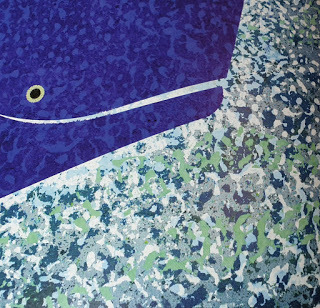 From There is a Tribe of Kids by Lane Smith (UK: Two Hoots, 2016)If you have any thoughts on illustrating water, or know of any great illustration examples, do share. Thanks! Paeony LewisClick here for my blog post on illustrating the night Or click here for all my blog posts And here is my ancient website, in dire need of a new look
From There is a Tribe of Kids by Lane Smith (UK: Two Hoots, 2016)If you have any thoughts on illustrating water, or know of any great illustration examples, do share. Thanks! Paeony LewisClick here for my blog post on illustrating the night Or click here for all my blog posts And here is my ancient website, in dire need of a new look

Looking harder at illustrations is always fun (in my opinion!), although sometimes I am stumped at how the artwork was created. For the first image, I'd never have known if the information hadn't been inside the book.
 Excerpt from The Hidden Forest by Australian author and illustrator,
Excerpt from The Hidden Forest by Australian author and illustrator, Jeannie Baker (UK: Walker Books, 2005)
The kelp was modelled with translucent artist's clay and the seawater is resin.
In The Hidden Forest I assume the lighting used in the photography mimics the natural reflection of light? However, sometimes simple paint can have the same impact, as seen below in Town is by the Sea.
 From Town is by the Sea by Joanne Schwartz, illustrated by Sydney Smith (UK: Walker Books, 2018)
From Town is by the Sea by Joanne Schwartz, illustrated by Sydney Smith (UK: Walker Books, 2018)This is the bright, blinding, shimmering sea.
Throughout the book there are many gorgeous, deceptively simple, atmospheric renderings of the sea.It can be easy to forget how much artistic effort goes into good picture books. I discovered a video where illustrator, Sydney Smith, ponders the illustration of this award-winning book and I thought some of you would be interested in the detail, so here goes…
From childhood, Sydney was familiar with the coast and for the book he visited the mining town of Glace Bay on the eastern tip of Nova Scotia, Canada, to “feel the size of the sea”. He viewed exhibitions too and for the water he absorbed the expressive brushwork of Turner, and the French Impressionists.
 From Town is by the Sea, another illustration of the sea by Sydney Smith.
From Town is by the Sea, another illustration of the sea by Sydney Smith.The quiet sea.Sidney’s principal tip on painting the sea is to decide on the type of sea. In the book there is the bright, blinding, shimmering sea, a choppy sea, a quiet sea, and a dark sea. Then Sidney suggests becoming the motion of the sea with your brush, “dance with your brush,” and don’t worry about detail because the sea is always moving. Be expressive.
Traditional watercolour is used for Town is by the Sea, along with Pentel brush pens and gouache paint (akin to watercolour mixed with chalk) used dry for the white frothy tips of the waves and the light. Sidney paints multiple versions of the sea double-page spreads, and then he keeps the one that seems to be going best. I suspect this is because although a lot of advance planning is needed, the watercolour is fluid and fast-drying, and so much depends on the specific brushstrokes.
 Here is detail from the bright, shimmering illustration by Sydney Smith.
Here is detail from the bright, shimmering illustration by Sydney Smith. You can see the individual expressive brushstrokes
and the white gouache applied over the watercolour. The next book, also an award winner, amazed me as it was all done with simple crayon and this gives it a contemporary retro look (you know what I mean!). If you saw my feeble efforts with coloured crayons, you'd understand my admiration. It's the narrative non-fiction children's picture book, Shakleton's Journey by young artist, William Grill. Here the white froth of the wave crests and light is simply white, uncrayoned paper.
 From Shakleton's Journey by William Grill (UK: Flying Eye Books, 2014)
From Shakleton's Journey by William Grill (UK: Flying Eye Books, 2014)
 More from Shakleton's Journey by William Grill
More from Shakleton's Journey by William GrillChurning, great waves, and we know they are enormous from the size of the boat..If you linger and stare at the illustration above, you'll see how there is 'simply' white blank paper separating blue directional lines of crayoned blue, but it's really effective. In an interview William says, “I try to work as loosely as I would in a sketch book… I’ll do it again and again until I’ve got it right, so it looks like I’ve just sketched it quickly.”
Even if you are a world-renowned illustrator, sometimes you discover an Achilles heel, and drawing churning water flummoxed French-born artist, Tomi Ungerer. In a video Tomi talks about Fog Island (then called Fog Man), and near the end discusses his path to solving the problem of the waves.
 Tomi Ungerer, talking about Fog Island.
Tomi Ungerer, talking about Fog Island. From Fog Island by Tomi Ungerer (UK: Phaidon Press, 2013)Tomi explains how all his life (born 1931) he had a hard time drawing waves, despite during his later life living by the sea in Nova Scotia, and then on an Irish island. It was with the above illustration for Fog Island that Tomi developed a new technique. When he first attempted the waves Tomi was inspired by Hokusai's wave, but he was told his interpretation lacked movement and looked frozen.
From Fog Island by Tomi Ungerer (UK: Phaidon Press, 2013)Tomi explains how all his life (born 1931) he had a hard time drawing waves, despite during his later life living by the sea in Nova Scotia, and then on an Irish island. It was with the above illustration for Fog Island that Tomi developed a new technique. When he first attempted the waves Tomi was inspired by Hokusai's wave, but he was told his interpretation lacked movement and looked frozen. Hokusai's waveSo Tomi Ungerer persevered and developed another technique. You might be able to see in the video image that Tomi uses semi-translucent tracing paper and he explains how green pastel was applied to the back of the transfer paper and pencil and gouache to the front, with extra, darker pastel where necessary. I was a little confused with the explanation, but that doesn't matter because what is inspiring is that an acclaimed artist experimented until the problem was solved, even though he was in his eighties. It was the same with the fog; Tomi assumed covering the drawing with light grey pastel would give the effect of fog, but discovered it wasn't that simple because real fog plays with perspective and he adapted that technique too.
Hokusai's waveSo Tomi Ungerer persevered and developed another technique. You might be able to see in the video image that Tomi uses semi-translucent tracing paper and he explains how green pastel was applied to the back of the transfer paper and pencil and gouache to the front, with extra, darker pastel where necessary. I was a little confused with the explanation, but that doesn't matter because what is inspiring is that an acclaimed artist experimented until the problem was solved, even though he was in his eighties. It was the same with the fog; Tomi assumed covering the drawing with light grey pastel would give the effect of fog, but discovered it wasn't that simple because real fog plays with perspective and he adapted that technique too.
Poignantly, whilst researching Tomi Ungerer, I discovered this maverick, acclaimed artist had died the day before, aged 87 years. My heart lurched.
Another acclaimed, award-winning artist, Leo Lionni (also now departed), used a very different technique for water. I've only just discovered Swimmy by Leo Lionni, and it is now a new favourite, despite being first published in 1963. I first heard of this book through reading Eric Cale and Lane Smith praising the book and it has been recently reissued in the UK. Leo was an artist/graphic designer who didn't start producing children's books until his fifties.
 Swimmy by Leo Lionni (UK: Andersen Press, 2015)
Swimmy by Leo Lionni (UK: Andersen Press, 2015)The cover is shown large so you can see the texture of the water.I gather Leo Lionni used a variety of mediums and for this book he used different stamps and printing, wax resist and plastic wrap (clingfilm) on diluted blue tempera paint. It gives such a feeling of loose, liquid, spontaneity. And the seaweed made me grin: he printed it using the ornamental edge of a napkin or doily. Maybe it is a little messy, but there is an innovative joy to the images and it oozes wetness!
 From Swimmy by Leo Lionni
From Swimmy by Leo LionniPerhaps some of my enthusiasm for Swimmy comes from the fact I've been experimenting with illustrating water on my course and only a week before seeing this book I'd been playing with watercolour and clingfilm. Snap! OK, I know I'm only a beginner, but as has been seen, all the professional illustrators experiment too.

 Paeony Lewis, having fun, experimenting.And finally, here are a few more examples of water from different children's picture book illustrators. Can you guess how they were created?
Paeony Lewis, having fun, experimenting.And finally, here are a few more examples of water from different children's picture book illustrators. Can you guess how they were created? From Bear Hug by Katharine McEwen (UK: Templar, 2014)
From Bear Hug by Katharine McEwen (UK: Templar, 2014) From Roo the Roaring Dinosaur: Best Playday Ever!
From Roo the Roaring Dinosaur: Best Playday Ever! by David Bedford, illustrated by Mandy Stanley (UK: Simon & Schuster, 2016)
 From The Journey by Francesca Sanna (UK: Flying Eye Books, 2016)
From The Journey by Francesca Sanna (UK: Flying Eye Books, 2016)
 From The Crocodile Who Didn't Like Water by Gemma Merino (UK: Macmillan, 2013)
From The Crocodile Who Didn't Like Water by Gemma Merino (UK: Macmillan, 2013) From There is a Tribe of Kids by Lane Smith (UK: Two Hoots, 2016)If you have any thoughts on illustrating water, or know of any great illustration examples, do share. Thanks! Paeony LewisClick here for my blog post on illustrating the night Or click here for all my blog posts And here is my ancient website, in dire need of a new look
From There is a Tribe of Kids by Lane Smith (UK: Two Hoots, 2016)If you have any thoughts on illustrating water, or know of any great illustration examples, do share. Thanks! Paeony LewisClick here for my blog post on illustrating the night Or click here for all my blog posts And here is my ancient website, in dire need of a new look
Published on February 11, 2019 00:00
February 3, 2019
The Perils of Being a Toy, by Mini Grey
 Toy underwater - from Mini's sketchbookIt’s not easy being a toy. You get mired in adventures out of your depths, dressed in outfits you never chose, and left in unlikely places by your forgetful owners. Toys are our avatars. They are mostly (happily) silent unless their owners voice for them. Children can’t help being animators – it happens to the first things that are picked up – they get brought to life.
Toy underwater - from Mini's sketchbookIt’s not easy being a toy. You get mired in adventures out of your depths, dressed in outfits you never chose, and left in unlikely places by your forgetful owners. Toys are our avatars. They are mostly (happily) silent unless their owners voice for them. Children can’t help being animators – it happens to the first things that are picked up – they get brought to life. Anything can be a Toy
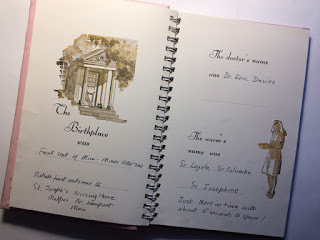 Mini's baby book from C1967
Mini's baby book from C1967 In my baby book, my mum records that when I was three I talked a lot about two persons called ‘Gully’ and ‘Linda’. My mum never knew who they were, though they were often up to stuff. But I know. They were my hands.
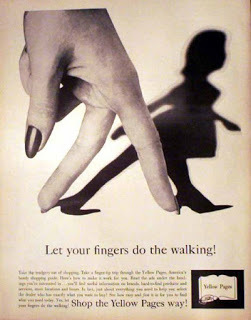 Those yellow pages fingers
Those yellow pages fingersYou know that thing where you can get your index and middle fingers to stride around like a pair of legs? Well that was Gully & Linda – I can’t remember who was right and who was left. They were possibly married. They used to do a lot of striding around on long car journeys.
Anything can be a toy. In the Edinburgh Museum of Childhood a few years ago I found this:
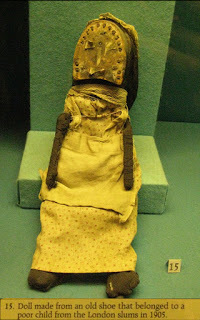 Shoe Doll
Shoe Doll It was someone’s doll once. What it also was, was the sole of a shoe.
Sometimes the most eloquent toys are the most basic – where imagination has had to do most of the animating. And the most disappointing of toys can be the ones who try to say and do too much. Here is Scrubbing Brush, who is basic...
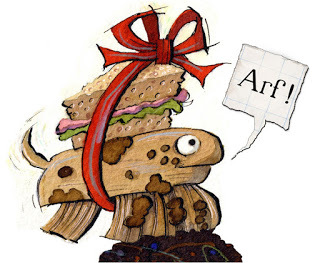 Scrubbing Brish carrying Lunch
Scrubbing Brish carrying Lunchand Turbodog, who says way too much.
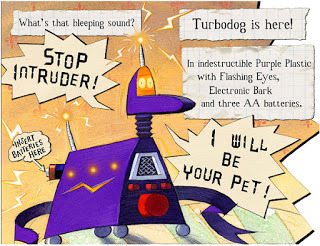 Turbodog - the most useless robotic dog there is...
Turbodog - the most useless robotic dog there is...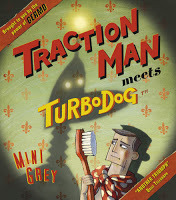 both from Traction Man Meets TurbodogChildren’s books are the theatre for toys to come to life, where toys really can have adventures. And I love books about toys having adventures.
both from Traction Man Meets TurbodogChildren’s books are the theatre for toys to come to life, where toys really can have adventures. And I love books about toys having adventures.So here are my Top Five Perils of Being a Picture Book Toy.
PERIL ONE: FALLING APART
It’s the big worry about being a toy. Not being able to regenerate unless someone repairs you can leave you in quite a mess. But the conundrum is: that falling apart makes you REAL. Let’s go first to That Rabbit Belongs To Emily Brown.
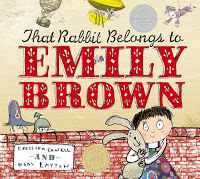 by Cressida Cowell and Neal Layton
by Cressida Cowell and Neal LaytonHere is Emily Brown’s rabbit Stanley in a terrible state after his kidnapping by the naughty queen:
 Something wrong with Stanley...from That Rabbit Belongs to Emily Brown by Cressida Cowell and Neal Layton
Something wrong with Stanley...from That Rabbit Belongs to Emily Brown by Cressida Cowell and Neal LaytonAfter she has rescued Stanley, the wise Emily Brown gives that Queen a recipe for making a Real Toy:
“You take that horrid brand new teddy bear and you play with him all day. Sleep with him at night. Hold him very tight and be sure to have lots of adventures. And then maybe one day you will wake up with a real toy of your own.”
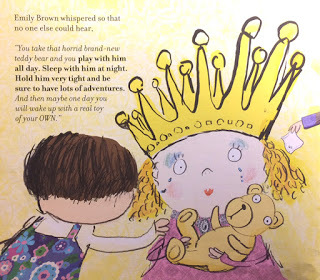 From That Rabbit belongs to Emily Brown by Cressida Cowell and Neal Layton
From That Rabbit belongs to Emily Brown by Cressida Cowell and Neal Layton So falling apart can be part of the process of Becoming Real.
For more on becoming real, we’ll have to go to The Velveteen Rabbit, written by Margery Williams with magical pictures by William Nicholson.
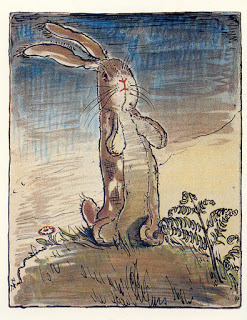 The Velveteen Rabbit by Margery Williams and pictures by William Nicholson
The Velveteen Rabbit by Margery Williams and pictures by William Nicholson Pondering over a toy’s life in the Nursery, the Skin Horse offers the Velveteen Rabbit this definition of real:
“Real isn’t how you’re made,” said the Skin Horse. “It’s a thing that happens to you…Generally, by the time you are Real, most of your hair has been loved off, and your eyes drop out and you get loose in the joints and very shabby. But these things don’t matter at all, because once you are Real you can’t be ugly, except to people who don’t understand.”There are many ways toys can fall apart: one is unravelling.
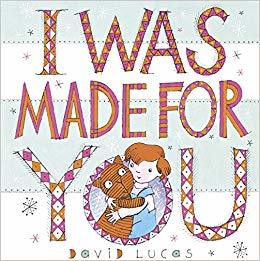 I Was Made For You by David LucasIn I Was Made For You by David Lucas a home-made knitted cat is destined to be a Christmas present but wakes up with the need to discover the answer to the biggest questions - not just what he is but whyhe is. The little toy goes in search of an answer to the big Why, but snags his wool on a rusty nail and unravels before our eyes until he is ‘just a long loose thread shivering in the wind’.
I Was Made For You by David LucasIn I Was Made For You by David Lucas a home-made knitted cat is destined to be a Christmas present but wakes up with the need to discover the answer to the biggest questions - not just what he is but whyhe is. The little toy goes in search of an answer to the big Why, but snags his wool on a rusty nail and unravels before our eyes until he is ‘just a long loose thread shivering in the wind’.  From I Was Made For You by David Lucas
From I Was Made For You by David LucasHe is precariously close to not being at all, but is found and wound by Daisy & her Mum, who reknits him into his shape again.
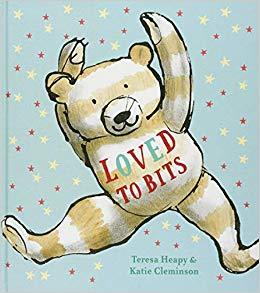 Loved To Bits by Teresa Heapy and Katie Cleminson
Loved To Bits by Teresa Heapy and Katie Cleminson Toys can be tested to destruction. In Loved to Bits by Teresa Heapy and Katie Cleminson, the toy here is Stripy Ted who bravely loses body parts while engaged in adventures with his owner.
Stripy Ted gallantly loses an ear (“Still got the best one – never fear!” he says cheerfully), an eye, and eventually both legs and both arms becoming only a ball and head.
But his owner prefers him in his brave unmended state.
 From Loved To Bits by Teresa Heapy and Katie CleminsonSo how much of yourself can you lose and still be you?
From Loved To Bits by Teresa Heapy and Katie CleminsonSo how much of yourself can you lose and still be you?You can come unstuffed, but you can also be remade.
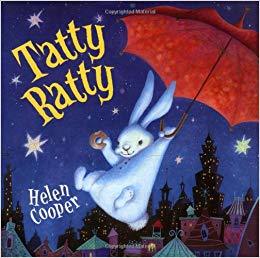 Tatty Ratty by Helen Cooper
Tatty Ratty by Helen CooperI think Tatty Ratty, by Helen Cooper, is perhaps a story about being remade, so that old loved tired lost Tatty Ratty can become new again, dusted with sugar & floating down from the moon.
Lost probably on the bus just before the story begins, Tatty Ratty is only seen in the journey of adventures back home that Molly and her Mum and Dad dream up for him. Tatty Ratty is always getting closer, and always getting a bit remade – feeding himself up on porridge to get restuffed, falling in the sea to become washed, being dusted with sugar on the moon for a touch of sparkle.
Finally the family are ready to track Tatty Ratty down at the Kingdom of Bunny. There could be a difficult moment here, when Molly spots the shelf of similar white bunnies with buttons who are all pretty much Tatty Ratty clones.
 From Tatty Ratty by Helen CooperBut Tatty Ratty’s imagined journey home has somehow prepared Molly to find the right one.
From Tatty Ratty by Helen CooperBut Tatty Ratty’s imagined journey home has somehow prepared Molly to find the right one.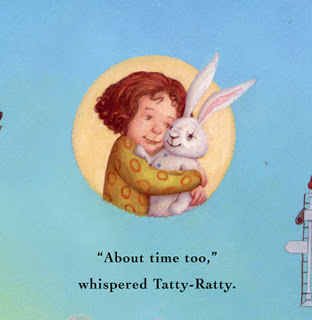
PERIL TWO: BEING LOST A perennial peril of being a toy due to their hapless, absent-minded and easily distracted owners, being Lost can happen anywhere.
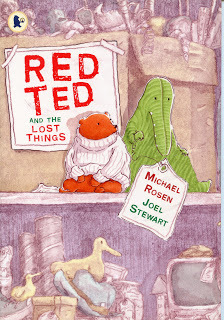 Red Ted and the Lost Things by Michael Rosen and Joel Stewart
Red Ted and the Lost Things by Michael Rosen and Joel StewartIn Red Ted and the Lost Things, Red Ted finds himself in a Lost Property Office having been left on a train, and along with a toy crocodile decides to pluckily find his own way home. I love seeing the little toys bravely navigate the confusing streets of the full-size world.
 From Red Ted and the Lost Things by Michael Rosen and Joel Stewart A nonchalant cheese-loving cat comes along for the ride. Red Ted is small but resourceful and the crocodile shows his teeth, seeing off a colossal dachshund. For the small toys the journey home is an epic struggle. Finally Red Ted is reunited with Stevie who makes everything right and has superpowers of understanding when it comes to toys and cats.
From Red Ted and the Lost Things by Michael Rosen and Joel Stewart A nonchalant cheese-loving cat comes along for the ride. Red Ted is small but resourceful and the crocodile shows his teeth, seeing off a colossal dachshund. For the small toys the journey home is an epic struggle. Finally Red Ted is reunited with Stevie who makes everything right and has superpowers of understanding when it comes to toys and cats. From Red Ted and the Lost Things by Michael Rosen and Joel StewartPERIL THREE: BEING SUPPLANTED, IGNORED, NOT PLAYED WITH, OR GIVEN AWAY These fates are too awful to think about - and they all do happen in the films Toy Story 1, 2 or 3 (EVERYTHING that can happen to toys happens in Toy Story somewhere.) Actually they are so awful I couldn't find picture book toys that get treated this way (any suggestions?), so here I'm resorting to a story of pure imagination...
From Red Ted and the Lost Things by Michael Rosen and Joel StewartPERIL THREE: BEING SUPPLANTED, IGNORED, NOT PLAYED WITH, OR GIVEN AWAY These fates are too awful to think about - and they all do happen in the films Toy Story 1, 2 or 3 (EVERYTHING that can happen to toys happens in Toy Story somewhere.) Actually they are so awful I couldn't find picture book toys that get treated this way (any suggestions?), so here I'm resorting to a story of pure imagination...The Story of the Bad Mump Mump
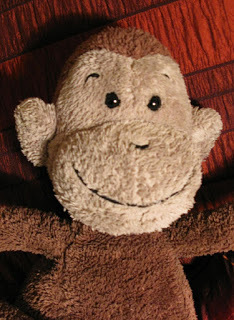 The real Mump Mump
The real Mump Mump
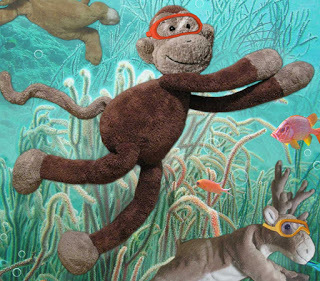 Underwater Fantasy Mump Mump
Underwater Fantasy Mump MumpWhen my son Herbie was 6 months old he was given this monkey. It was a good one – long legs, squashy round body, perfect bedtime companion. It wasn’t till a year later that we found out from Herbie that the monkey’s name was Mump Mump.
So all was well.
One day I was idly wandering round the toy department of Fenwick’s on Bond Street and I discovered an entire bin of Mump Mumps, probably on special offer. Ooh! - I thought - I could buy a spare Mump Mump! Just in case. We’d never ever have a lost or destroyed Mump Mump crisis!
Reader, I nearly did it. But I didn’t.
On the bus home I realised the full horror of what I could have done. Imagine the life of the Other Mump Mump.
Consigned to a cupboard – (as your existence must always be a secret to the child you are meant to be for) - you watch - (probably through a chink in the cupboard door) - as your child talks and plays and sleeps with the other hated Mump Mump.
In your cupboard over the long years you plot out ways to despatch your rival Mump Mump. Maybe the day comes when the blow finally falls and the other Mump Mump is left on a beach or dropped off a ferry or mysteriously set on fire and at last you can take your rightful place at the heart of your child’s world.
But no – the long years in the cupboard will have taken their toll and you will be somehow poisoned and bitter inside.
Maybe not the best picture book material.
But with 'given away' I'm going to mention Dogger here.
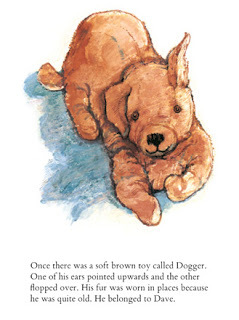 From Dogger by Shirley Hughes
From Dogger by Shirley Hughes
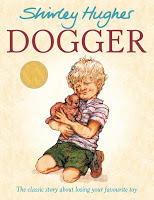 Dogger by Shirley HughesDogger is lost and found and nearly lost again.Dogger's owner is Dave. Dogger isn't actually given away, he is lost then ends up on a toy stall at the school fete - but we see the loved toy ending up on a table with a '5p' label hanging on them. Dogger is perilously close to going home with another child. Some ingenious bargaining by Dave's sister Bella saves the day.
Dogger by Shirley HughesDogger is lost and found and nearly lost again.Dogger's owner is Dave. Dogger isn't actually given away, he is lost then ends up on a toy stall at the school fete - but we see the loved toy ending up on a table with a '5p' label hanging on them. Dogger is perilously close to going home with another child. Some ingenious bargaining by Dave's sister Bella saves the day.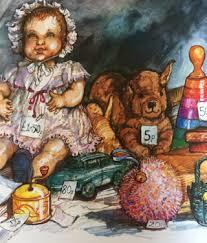 PERIL FOUR: The hard-working life of a toy which may include having to take the blame...
PERIL FOUR: The hard-working life of a toy which may include having to take the blame...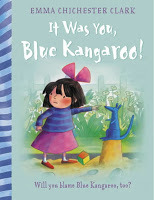 It Was You, Blue Kangaroo! by Emma Chichester ClarkPicture book toys often have to work hard for their owners. Blue Kangaroo, being a quiet sort, doesn't point out the unfairness of being repeatedly incriminated for his owner Lily's mishaps.
It Was You, Blue Kangaroo! by Emma Chichester ClarkPicture book toys often have to work hard for their owners. Blue Kangaroo, being a quiet sort, doesn't point out the unfairness of being repeatedly incriminated for his owner Lily's mishaps.Eventually Lily's mum puts Blue Kangaroo on a high shelf and Lily has to go to bed without him.
The page I love (I think it’s the shadow that makes it so exciting) is this page of blues as Blue Kangaroo jumps down from the bookcase where he’s been banished with an idea about how to put things right.
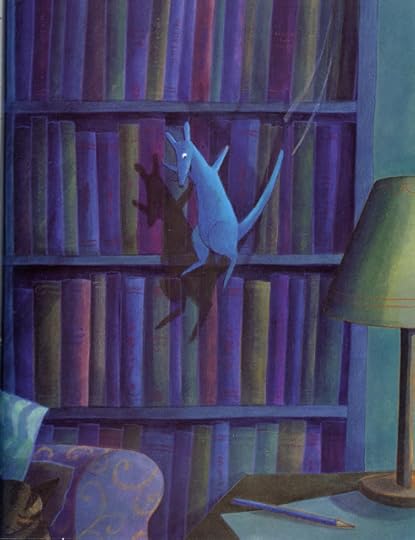 From It Was You, Blue Kangaroo! by Emma Chichester ClarkHere is a collection of toys (and an actual cat) grouped round our son Herbie when he was fairly new. When he was very little it always seemed important that he be surrounded by a sort of glow from his stuffed guardians.
From It Was You, Blue Kangaroo! by Emma Chichester ClarkHere is a collection of toys (and an actual cat) grouped round our son Herbie when he was fairly new. When he was very little it always seemed important that he be surrounded by a sort of glow from his stuffed guardians.  The guardians of Baby Herbie's Kingdom
The guardians of Baby Herbie's KingdomIn While You are Sleeping by Alexis Deacon, the bedside toys are hard at work every night, protecting, checking, scaring bad dreams away, tending their child. There's a gathering of guardians around the bedside. Alexis Deacon's warm pastel pictures conjure up a mysterious dark tender night-time world.
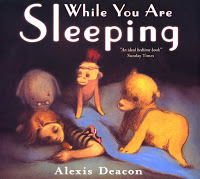 While You Are Sleeping by Alexis Deacon
While You Are Sleeping by Alexis Deacon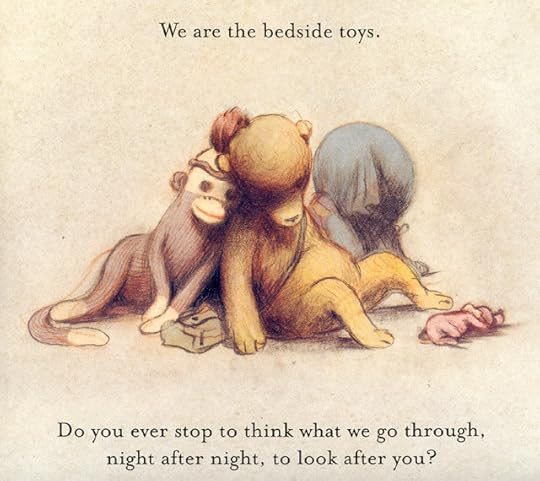 From While You Are Sleeping by Alexis Deacon
From While You Are Sleeping by Alexis Deacon From While You Are Sleeping by Alexis Deacon
From While You Are Sleeping by Alexis DeaconBeing a toy is a serious business, a life or death struggle, a battle.There are rules to being a picture book toy. Your owner will know you are alive but this is something they believe without seeing. You generally don’t come to life in front of them. It might freak them out. You don’t come to life around any humans (except maybe strange slightly magical ones.) You can only wander about when no people are watching you. Animals can probably see you and sometimes even understand/talk to you.
 From Red Ted and the Lost Things by Michael Rosen and Joel StewartWhen I was making Toys in Space I had a picture in my mind of a group of toys being left on the grass in the garden overnight for the first time. They’d see the stars and wonder what they were.
From Red Ted and the Lost Things by Michael Rosen and Joel StewartWhen I was making Toys in Space I had a picture in my mind of a group of toys being left on the grass in the garden overnight for the first time. They’d see the stars and wonder what they were.  From Toys in Space by MiniWhat else would happen? I badly wanted them to be abducted by an alien. However I wanted also to be brutally realistic, so the story of Toys in Space was my way for having Toys simultaneously abducted by aliens and not abducted by aliens.
From Toys in Space by MiniWhat else would happen? I badly wanted them to be abducted by an alien. However I wanted also to be brutally realistic, so the story of Toys in Space was my way for having Toys simultaneously abducted by aliens and not abducted by aliens. 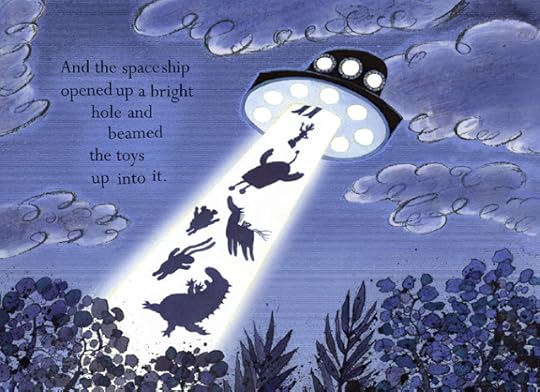
To get through a night out in the garden, they tell a story (which is where the beaming up comes in) until at last dawn happens and the sun comes out and they know they will be found.

PERIL FIVE: Your Owner GROWS UPThe Unspoken Tragedy in every toy’s life – is that its owner will grow up, the end of childhood.
On the final page of The House at Pooh Corner, Christopher Robin says:
“Pooh, promise you won’t forget about me, ever. Not even when I’m a hundred.”
Pooh thought for a while.
“How old shall I be then?”
“Ninety-nine.”
Pooh nodded.
“I promise,” he said.
Still with his eyes on the world Christopher Robin put out a hand and felt for Pooh’s paw.
“Pooh,” said Christopher Robin earnestly, “if I – if I’m not quite -” he stopped and tried again – “Pooh, whatever happens, you will understand, won’t you?"
The fate of a toy is to not grow, not change except to get worn and torn and be the victim of entropy, while your owner grows and changes and inevitably always grows up. But a toy is also potentially immortal if it doesn’t get too distressed, which its owner never is. So our toys have the potential to outlive us. In Bethnal Green Museum of Childhood live a huge collection of toys
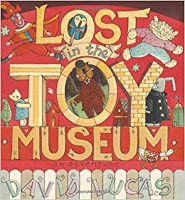 Lost in the Toy Museum by David Lucas who have outlasted their owners. In David Lucas’s Lost in the Toy Museum Bunting the Cat and the collection of historic toys romp their way through a game of hide and seek in the Museum.
Lost in the Toy Museum by David Lucas who have outlasted their owners. In David Lucas’s Lost in the Toy Museum Bunting the Cat and the collection of historic toys romp their way through a game of hide and seek in the Museum.
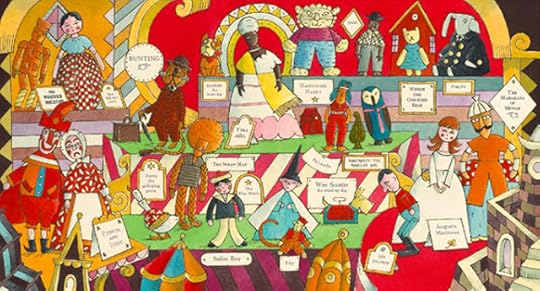 From Lost in the Toy Museum by David Lucas
From Lost in the Toy Museum by David Lucas AND LASTLY...Toy Names very often seem to have to state the bleeding obvious…so we have Red Ted, Stripy Ted, Blue Bear….
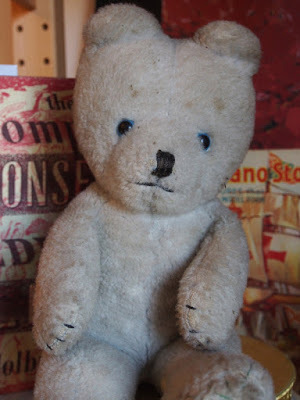 Blue BearHere is my Blue Bear who sits on my shelf in an encouraging way... But I always feel that Blue Bear is only a breath away from getting up and stumping off and having adventures of his own.
Blue BearHere is my Blue Bear who sits on my shelf in an encouraging way... But I always feel that Blue Bear is only a breath away from getting up and stumping off and having adventures of his own.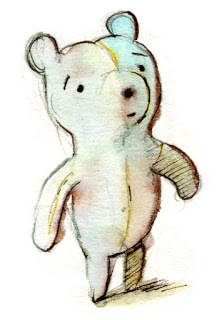
And perhaps one day he will.

Mini Grey makes picture books, and some of them have been about toys having adventures.
For more about lost toys, here's the tale of a lost whale on Sketching Weakly, Mini's sketch-blog.
PS - Have you a favourite Picture Book toy that I've missed? Do let me know!
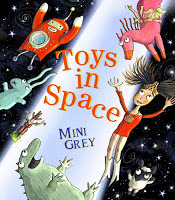
Published on February 03, 2019 22:00
The Perils of Being a Toy
by Mini Grey
 Toy underwater - from Mini's sketchbookIt’s not easy being a toy. You get mired in adventures out of your depths, dressed in outfits you never chose, and left in unlikely places by your forgetful owners. Toys are our avatars. They are mostly (happily) silent unless their owners voice for them. Children can’t help being animators – it happens to the first things that are picked up – they get brought to life.
Toy underwater - from Mini's sketchbookIt’s not easy being a toy. You get mired in adventures out of your depths, dressed in outfits you never chose, and left in unlikely places by your forgetful owners. Toys are our avatars. They are mostly (happily) silent unless their owners voice for them. Children can’t help being animators – it happens to the first things that are picked up – they get brought to life. Anything can be a Toy
 Mini's baby book from C1967
Mini's baby book from C1967 In my baby book, my mum records that when I was three I talked a lot about two persons called ‘Gully’ and ‘Linda’. My mum never knew who they were, though they were often up to stuff. But I know. They were my hands.
 Those yellow pages fingers
Those yellow pages fingersYou know that thing where you can get your index and middle fingers to stride around like a pair of legs? Well that was Gully & Linda – I can’t remember who was right and who was left. They were possibly married. They used to do a lot of striding around on long car journeys.
Anything can be a toy. In the Edinburgh Museum of Childhood a few years ago I found this:
 Shoe Doll
Shoe Doll It was someone’s doll once. What it also was, was the sole of a shoe.
Sometimes the most eloquent toys are the most basic – where imagination has had to do most of the animating. And the most disappointing of toys can be the ones who try to say and do too much. Here is Scrubbing Brush, who is basic...
 Scrubbing Brish carrying Lunch
Scrubbing Brish carrying Lunchand Turbodog, who says way too much.
 Turbodog - the most useless robotic dog there is...
Turbodog - the most useless robotic dog there is... both from Traction Man Meets TurbodogChildren’s books are the theatre for toys to come to life, where toys really can have adventures. And I love books about toys having adventures.
both from Traction Man Meets TurbodogChildren’s books are the theatre for toys to come to life, where toys really can have adventures. And I love books about toys having adventures.So here are my Top Five Perils of Being a Picture Book Toy.
PERIL ONE: FALLING APART
It’s the big worry about being a toy. Not being able to regenerate unless someone repairs you can leave you in quite a mess. But the conundrum is: that falling apart makes you REAL. Let’s go first to That Rabbit Belongs To Emily Brown.
 by Cressida Cowell and Neal Layton
by Cressida Cowell and Neal LaytonHere is Emily Brown’s rabbit Stanley in a terrible state after his kidnapping by the naughty queen:
 Something wrong with Stanley...from That Rabbit Belongs to Emily Brown by Cressida Cowell and Neal Layton
Something wrong with Stanley...from That Rabbit Belongs to Emily Brown by Cressida Cowell and Neal LaytonAfter she has rescued Stanley, the wise Emily Brown gives that Queen a recipe for making a Real Toy:
“You take that horrid brand new teddy bear and you play with him all day. Sleep with him at night. Hold him very tight and be sure to have lots of adventures. And then maybe one day you will wake up with a real toy of your own.”
 From That Rabbit belongs to Emily Brown by Cressida Cowell and Neal Layton
From That Rabbit belongs to Emily Brown by Cressida Cowell and Neal Layton So falling apart can be part of the process of Becoming Real.
For more on becoming real, we’ll have to go to The Velveteen Rabbit, written by Margery Williams with magical pictures by William Nicholson.
 The Velveteen Rabbit by Margery Williams and pictures by William Nicholson
The Velveteen Rabbit by Margery Williams and pictures by William Nicholson Pondering over a toy’s life in the Nursery, the Skin Horse offers the Velveteen Rabbit this definition of real:
“Real isn’t how you’re made,” said the Skin Horse. “It’s a thing that happens to you…Generally, by the time you are Real, most of your hair has been loved off, and your eyes drop out and you get loose in the joints and very shabby. But these things don’t matter at all, because once you are Real you can’t be ugly, except to people who don’t understand.”There are many ways toys can fall apart: one is unravelling.
 I Was Made For You by David LucasIn I Was Made For You by David Lucas a home-made knitted cat is destined to be a Christmas present but wakes up with the need to discover the answer to the biggest questions - not just what he is but whyhe is. The little toy goes in search of an answer to the big Why, but snags his wool on a rusty nail and unravels before our eyes until he is ‘just a long loose thread shivering in the wind’.
I Was Made For You by David LucasIn I Was Made For You by David Lucas a home-made knitted cat is destined to be a Christmas present but wakes up with the need to discover the answer to the biggest questions - not just what he is but whyhe is. The little toy goes in search of an answer to the big Why, but snags his wool on a rusty nail and unravels before our eyes until he is ‘just a long loose thread shivering in the wind’.  From I Was Made For You by David Lucas
From I Was Made For You by David LucasHe is precariously close to not being at all, but is found and wound by Daisy & her Mum, who reknits him into his shape again.
 Loved To Bits by Teresa Heapy and Katie Cleminson
Loved To Bits by Teresa Heapy and Katie Cleminson Toys can be tested to destruction. In Loved to Bits by Teresa Heapy and Katie Cleminson, the toy here is Stripy Ted who bravely loses body parts while engaged in adventures with his owner.
Stripy Ted gallantly loses an ear (“Still got the best one – never fear!” he says cheerfully), an eye, and eventually both legs and both arms becoming only a ball and head.
But his owner prefers him in his brave unmended state.
 From Loved To Bits by Teresa Heapy and Katie CleminsonSo how much of yourself can you lose and still be you?
From Loved To Bits by Teresa Heapy and Katie CleminsonSo how much of yourself can you lose and still be you?You can come unstuffed, but you can also be remade.
 Tatty Ratty by Helen Cooper
Tatty Ratty by Helen CooperI think Tatty Ratty, by Helen Cooper, is perhaps a story about being remade, so that old loved tired lost Tatty Ratty can become new again, dusted with sugar & floating down from the moon.
Lost probably on the bus just before the story begins, Tatty Ratty is only seen in the journey of adventures back home that Molly and her Mum and Dad dream up for him. Tatty Ratty is always getting closer, and always getting a bit remade – feeding himself up on porridge to get restuffed, falling in the sea to become washed, being dusted with sugar on the moon for a touch of sparkle.
Finally the family are ready to track Tatty Ratty down at the Kingdom of Bunny. There could be a difficult moment here, when Molly spots the shelf of similar white bunnies with buttons who are all pretty much Tatty Ratty clones.
 From Tatty Ratty by Helen CooperBut Tatty Ratty’s imagined journey home has somehow prepared Molly to find the right one.
From Tatty Ratty by Helen CooperBut Tatty Ratty’s imagined journey home has somehow prepared Molly to find the right one.
PERIL TWO: BEING LOST A perennial peril of being a toy due to their hapless, absent-minded and easily distracted owners, being Lost can happen anywhere.
 Red Ted and the Lost Things by Michael Rosen and Joel Stewart
Red Ted and the Lost Things by Michael Rosen and Joel StewartIn Red Ted and the Lost Things, Red Ted finds himself in a Lost Property Office having been left on a train, and along with a toy crocodile decides to pluckily find his own way home. I love seeing the little toys bravely navigate the confusing streets of the full-size world.
 From Red Ted and the Lost Things by Michael Rosen and Joel Stewart A nonchalant cheese-loving cat comes along for the ride. Red Ted is small but resourceful and the crocodile shows his teeth, seeing off a colossal dachshund. For the small toys the journey home is an epic struggle. Finally Red Ted is reunited with Stevie who makes everything right and has superpowers of understanding when it comes to toys and cats.
From Red Ted and the Lost Things by Michael Rosen and Joel Stewart A nonchalant cheese-loving cat comes along for the ride. Red Ted is small but resourceful and the crocodile shows his teeth, seeing off a colossal dachshund. For the small toys the journey home is an epic struggle. Finally Red Ted is reunited with Stevie who makes everything right and has superpowers of understanding when it comes to toys and cats. From Red Ted and the Lost Things by Michael Rosen and Joel StewartPERIL THREE: BEING SUPPLANTED, IGNORED, NOT PLAYED WITH, OR GIVEN AWAY These fates are too awful to think about - and they all do happen in the films Toy Story 1, 2 or 3 (EVERYTHING that can happen to toys happens in Toy Story somewhere.) Actually they are so awful I couldn't find picture book toys that get treated this way (any suggestions?), so here I'm resorting to a story of pure imagination...
From Red Ted and the Lost Things by Michael Rosen and Joel StewartPERIL THREE: BEING SUPPLANTED, IGNORED, NOT PLAYED WITH, OR GIVEN AWAY These fates are too awful to think about - and they all do happen in the films Toy Story 1, 2 or 3 (EVERYTHING that can happen to toys happens in Toy Story somewhere.) Actually they are so awful I couldn't find picture book toys that get treated this way (any suggestions?), so here I'm resorting to a story of pure imagination...The Story of the Bad Mump Mump
 The real Mump Mump
The real Mump Mump
 Underwater Fantasy Mump Mump
Underwater Fantasy Mump MumpWhen my son Herbie was 6 months old he was given this monkey. It was a good one – long legs, squashy round body, perfect bedtime companion. It wasn’t till a year later that we found out from Herbie that the monkey’s name was Mump Mump.
So all was well.
One day I was idly wandering round the toy department of Fenwick’s on Bond Street and I discovered an entire bin of Mump Mumps, probably on special offer. Ooh! - I thought - I could buy a spare Mump Mump! Just in case. We’d never ever have a lost or destroyed Mump Mump crisis!
Reader, I nearly did it. But I didn’t.
On the bus home I realised the full horror of what I could have done. Imagine the life of the Other Mump Mump.
Consigned to a cupboard – (as your existence must always be a secret to the child you are meant to be for) - you watch - (probably through a chink in the cupboard door) - as your child talks and plays and sleeps with the other hated Mump Mump.
In your cupboard over the long years you plot out ways to despatch your rival Mump Mump. Maybe the day comes when the blow finally falls and the other Mump Mump is left on a beach or dropped off a ferry or mysteriously set on fire and at last you can take your rightful place at the heart of your child’s world.
But no – the long years in the cupboard will have taken their toll and you will be somehow poisoned and bitter inside.
Maybe not the best picture book material.
But with 'given away' I'm going to mention Dogger here.
 From Dogger by Shirley Hughes
From Dogger by Shirley Hughes
 Dogger by Shirley HughesDogger is lost and found and nearly lost again.Dogger's owner is Dave. Dogger isn't actually given away, he is lost then ends up on a toy stall at the school fete - but we see the loved toy ending up on a table with a '5p' label hanging on them. Dogger is perilously close to going home with another child. Some ingenious bargaining by Dave's sister Bella saves the day.
Dogger by Shirley HughesDogger is lost and found and nearly lost again.Dogger's owner is Dave. Dogger isn't actually given away, he is lost then ends up on a toy stall at the school fete - but we see the loved toy ending up on a table with a '5p' label hanging on them. Dogger is perilously close to going home with another child. Some ingenious bargaining by Dave's sister Bella saves the day. PERIL FOUR: The hard-working life of a toy which may include having to take the blame...
PERIL FOUR: The hard-working life of a toy which may include having to take the blame... It Was You, Blue Kangaroo! by Emma Chichester ClarkPicture book toys often have to work hard for their owners. Blue Kangaroo, being a quiet sort, doesn't point out the unfairness of being repeatedly incriminated for his owner Lily's mishaps.
It Was You, Blue Kangaroo! by Emma Chichester ClarkPicture book toys often have to work hard for their owners. Blue Kangaroo, being a quiet sort, doesn't point out the unfairness of being repeatedly incriminated for his owner Lily's mishaps.Eventually Lily's mum puts Blue Kangaroo on a high shelf and Lily has to go to bed without him.
The page I love (I think it’s the shadow that makes it so exciting) is this page of blues as Blue Kangaroo jumps down from the bookcase where he’s been banished with an idea about how to put things right.
 From It Was You, Blue Kangaroo! by Emma Chichester ClarkHere is a collection of toys (and an actual cat) grouped round our son Herbie when he was fairly new. When he was very little it always seemed important that he be surrounded by a sort of glow from his stuffed guardians.
From It Was You, Blue Kangaroo! by Emma Chichester ClarkHere is a collection of toys (and an actual cat) grouped round our son Herbie when he was fairly new. When he was very little it always seemed important that he be surrounded by a sort of glow from his stuffed guardians.  The guardians of Baby Herbie's Kingdom
The guardians of Baby Herbie's KingdomIn While You are Sleeping by Alexis Deacon, the bedside toys are hard at work every night, protecting, checking, scaring bad dreams away, tending their child. There's a gathering of guardians around the bedside. Alexis Deacon's warm pastel pictures conjure up a mysterious dark tender night-time world.
 While You Are Sleeping by Alexis Deacon
While You Are Sleeping by Alexis Deacon From While You Are Sleeping by Alexis Deacon
From While You Are Sleeping by Alexis Deacon From While You Are Sleeping by Alexis Deacon
From While You Are Sleeping by Alexis DeaconBeing a toy is a serious business, a life or death struggle, a battle.There are rules to being a picture book toy. Your owner will know you are alive but this is something they believe without seeing. You generally don’t come to life in front of them. It might freak them out. You don’t come to life around any humans (except maybe strange slightly magical ones.) You can only wander about when no people are watching you. Animals can probably see you and sometimes even understand/talk to you.
 From Red Ted and the Lost Things by Michael Rosen and Joel StewartWhen I was making Toys in Space I had a picture in my mind of a group of toys being left on the grass in the garden overnight for the first time. They’d see the stars and wonder what they were.
From Red Ted and the Lost Things by Michael Rosen and Joel StewartWhen I was making Toys in Space I had a picture in my mind of a group of toys being left on the grass in the garden overnight for the first time. They’d see the stars and wonder what they were.  From Toys in Space by MiniWhat else would happen? I badly wanted them to be abducted by an alien. However I wanted also to be brutally realistic, so the story of Toys in Space was my way for having Toys simultaneously abducted by aliens and not abducted by aliens.
From Toys in Space by MiniWhat else would happen? I badly wanted them to be abducted by an alien. However I wanted also to be brutally realistic, so the story of Toys in Space was my way for having Toys simultaneously abducted by aliens and not abducted by aliens.  To get through a night out in the garden, they tell a story (which is where the beaming up comes in) until at last dawn happens and the sun comes out and they know they will be found.
To get through a night out in the garden, they tell a story (which is where the beaming up comes in) until at last dawn happens and the sun comes out and they know they will be found.
PERIL FIVE: Your Owner GROWS UPThe Unspoken Tragedy in every toy’s life – is that its owner will grow up, the end of childhood.
On the final page of The House at Pooh Corner, Christopher Robin says:
“Pooh, promise you won’t forget about me, ever. Not even when I’m a hundred.”
Pooh thought for a while.
“How old shall I be then?”
“Ninety-nine.”
Pooh nodded.
“I promise,” he said.
Still with his eyes on the world Christopher Robin put out a hand and felt for Pooh’s paw.
“Pooh,” said Christopher Robin earnestly, “if I – if I’m not quite -” he stopped and tried again – “Pooh, whatever happens, you will understand, won’t you?"
The fate of a toy is to not grow, not change except to get worn and torn and be the victim of entropy, while your owner grows and changes and inevitably always grows up. But a toy is also potentially immortal if it doesn’t get too distressed, which its owner never is. So our toys have the potential to outlive us. In Bethnal Green Museum of Childhood live a huge collection of toys
 Lost in the Toy Museum by David Lucas who have outlasted their owners. In David Lucas’s Lost in the Toy Museum Bunting the Cat and the collection of historic toys romp their way through a game of hide and seek in the Museum.
Lost in the Toy Museum by David Lucas who have outlasted their owners. In David Lucas’s Lost in the Toy Museum Bunting the Cat and the collection of historic toys romp their way through a game of hide and seek in the Museum.
 From Lost in the Toy Museum by David Lucas
From Lost in the Toy Museum by David Lucas AND LASTLY...Toy Names very often seem to have to state the bleeding obvious…so we have Red Ted, Stripy Ted, Blue Bear….
 Blue BearHere is my Blue Bear who sits on my shelf in an encouraging way... But I always feel that Blue Bear is only a breath away from getting up and stumping off and having adventures of his own.
Blue BearHere is my Blue Bear who sits on my shelf in an encouraging way... But I always feel that Blue Bear is only a breath away from getting up and stumping off and having adventures of his own.
And perhaps one day he will.

Mini Grey makes picture books, and some of them have been about toys having adventures.
For more about lost toys, here's the tale of a lost whale on Sketching Weakly, Mini's sketch-blog.
PS - Have you a favourite Picture Book toy that I've missed? Do let me know!

Published on February 03, 2019 22:00
January 28, 2019
Trying to make it work in the age of Universal Credits: some ideas to earn more money as an author in 2019 by Juliet Clare Bell
For people on a low household income, Universal Credits (or Child Tax Credits/Working Tax Credits as they currently are for many people) can be a critical part of their family budget. If you are a writer and have school-aged children, and in particular if you are a single parent, or your partner is also low waged, you may well be on tax credits already and in various states of nervousness about what happens when you are moved onto Universal Credits. Or you may already be on Universal Credits. This post looks at ideas for how we as authors might earn more money in 2019 –whether or not you are on tax credits –but for those of us on Universal Credits or still on tax credits, earning a minimum threshold level as a freelancer has become a necessity.
MORE MANUSCRIPTS ACCEPTED BY PUBLISHERS AND MORE AUTHOR VISITS
At its most basic, it boils down to this (and I’m using me as an example –it might be different for you): I need to have more picture book manuscripts accepted by publishers and I need to get more school visits. This is where my income comes from. So what can I do to get more of each?
ACCOUNTABILITY PARTNER
I now have a wonderful accountability partner who is on Universal Credits and also needs to earn consistently more money as an author than she has averaged in the past. We are using rough estimates of how much we need to earn a day/week/month in order to count as being freelance for Universal Credits and then deciding whether different projects are worth attempting financially and how much we have to gain from spending time on something like updating a website which doesn’t bring in money just by being there, but which we hope will attract more teachers (and more author visits) etc when it’s done. Until your youngest child turns thirteen, in order to count as being freelance for Universal Credits, you need to be working the equivalent of 25 hours per week at minimum wage, which equates to earning around £50 per day throughout the year –if you’re working five days a week (when your youngest reaches thirteen, it’s 37.5 hours per week, so you’ll have to earn quite a lot more). This is not exact but it helps when working out which projects to work on. If you’re working on something that will earn you less than £50 a day, you’ll need to be earning more on another project to make up for it. My accountability partner and I skype each other once a week and talk through our plans for the week, what we achieved the previous week, and what new opportunities we've found.
MORE MANUSCRIPTS ACCEPTED BY PUBLISHERS
We’re working on the assumption that if we write more manuscripts (and write them well), we have a greater chance of more manuscripts being picked up by a publisher –which seems a fair enough assumption. So we have each committed to writing a picture book manuscript every month and giving it to the other to critique on the last day of the month, each month. We know that our feedback will help the other as we’ve been critique partners for well over ten years. The hit rate of manuscripts being submitted to manuscripts being accepted is quite low even for successful picture book authors, and of course, we’d love for all our manuscripts to be accepted, but writing more (as long as they’re good –and we’ll make sure we’re doing that) is still likely to increase the number of manuscripts that get picked up (we’ve also got critique groups and agents to share work with but the fact that we’ve committed to writing twelve feels like we’re properly accountable and that we’ll actually do it.)
NONFICTION MANUSCRIPTS
There are some wonderful nonfiction picture books around. Two of the many that I love are:
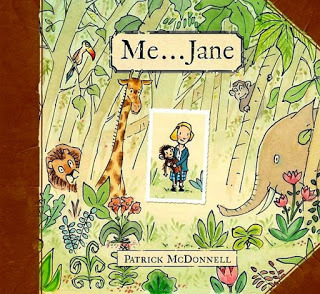
Me... Jane by Patrick McDonnell (Little Brown, 2011)about Jane Goodall, and
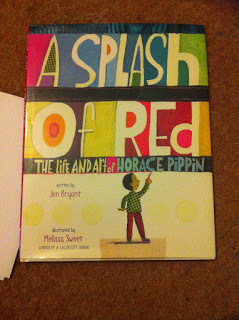
A Splash of Red: The Life and Art of Horace Pippin by Jen Bryant and Melissa Stewart (Knopf, 2013)
Having taken quite a break from writing nonfiction manuscripts, this year I’ve committed to writing at least three (as part of the twelve manuscripts overall). With a massive incentive to get more manuscripts taken on by publishers this year, I’ve been practical on how I should break it down. I was commissioned to write a narrative nonfiction picture book about the Cadburys several years ago (here's a blogpost I wrote about it at the time) and it was a brilliant experience for me. I was fired up to write lots more nonfiction and wrote a Picture Book Den blog about it, with suggestions for coming up with nonfiction picture book ideas . And because of the post, I was contacted by a publisher to go and talk with them about my ideas. After what seemed like an extremely successful meeting with three members of their team, I was hopeful that I would be writing more nonfiction but it was before narrative nonfiction had taken off in the UK (it had really taken off in the US) and they decided that it wasn’t financially viable at that time. Given the time involved in researching and writing a nonfiction picture book, I didn’t pursue them much after that as other editors were saying the same –for the UK market at least.
BUT THINGS HAVE CHANGED!Many editors in the UK are now saying they’re really interested in narrative nonfiction, so it seems like a properly fruitful avenue to pursue again –especially since I’ve already written one, and I used to be a research psychologist –so I love researching. Anyone out there who likes the idea of writing narrative nonfiction picture books, according to quite a lot of picture book editors I’ve spoken with/seen at events in the past six months, the time to do it is
NOW!
AUTHOR VISITSI do a reasonable number of author visits and I really like them. And –as I’m sure many of you are- I’m good at them –because I like them. I genuinely really like children (I was a research developmental psychologist before I started writing and always did lots of babysitting when I was younger –as I’d always liked children) and I love doing assemblies to hundreds of children –and working with them in smaller groups, trying to encourage them in their creativity. Lots of writers don’t like author visits, and fair enough, but whilst I love writing at home on my own, I also love the contrast of a noisy, energetic mass of children in a school. But I don’t do enough. Even though I like the visits, I have not been good at the self-promotion and going out at getting the visits for myself.
So I have committed with my accountability partner to:
[1] Revamping my website to make it easier for teachers to find an author who wants to do school visits
[2] Making it clear what I do on them (Candy Gourlay’s advice on making your website teacher-friendly at last year’s SCBWI conference was brilliant)
[3] Increasing the types of sessions I can do. You might want to think about this, too. What is it about you and your books that means you can do something different in your sessions from other people? Try taking each of your books and thinking what specific sessions you could offer that relate to that book. I’ve had a go at doing it with some of my books, below:
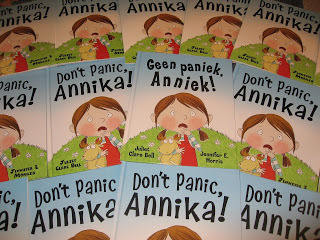
(c) Don't Panic, Annika! (illustrated by Jennifer E Morris, 2011)
Don’t Panic, Annika! (illustrated by Jennifer E Morris) is about a child who in anxious but overcomes her fears –so I’m going to develop a specific session I can do relating to that (on top of the sessions I already do), and given my background in psychology, I feel comfortable doing this.
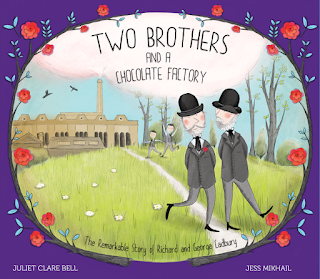
Two Brothers and a Chocolate Factory: The Remarkable Story of Richard and George Cadbury (illustrated by Jess Mikhail, 2016)
Lots of schools study local Victorians and/or chocolate. I’ve done sessions on this (I did one last week –because a teacher had my book and realised I was local and asked) but I’ve never advertised it as an option.
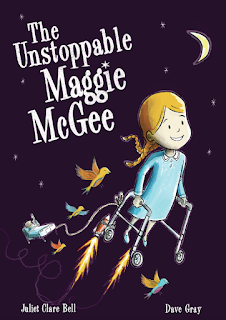
The Unstoppable Maggie McGee (illustrated by Dave Gray 2015)
This is a story about resilience and the importance of imagination, and the main character has a serious disability which means that she's often in hospital. I’m hugely interested in resilience in children (especially with my background in psychology) and I’m a really keen advocate of better diversity in children’s stories. I can absolutely do sessions specifically on resilience, and would love to do more work with children with disabilities (as I did before creating the story).
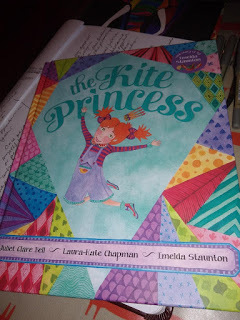
The Kite Princess (illustrated by Laura-Kate Chapman; Barefoot Books, 2012)
The Kite Princess could be the starting point for a great session talking about empowerment (Amnesty International UK even sold it) but did I offer a session on empowerment as a possibility on my website? No!
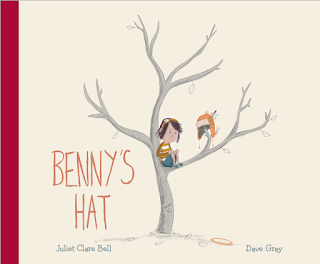
Benny's Hat (illustrated by Dave Gray, Pomelo Pip, 2016)
And Benny’s Hat (illustrated by Dave Gray) is about sibling bereavement. There won’t be many schools who’d like to do a focus on bereavement, but there absolutely might be some, and Dave and I worked with many bereaved and pre-bereaved children and with young people with life-limiting conditions when we were creating the book –and we did lots of events, too, but not in schools. And there’s nothing on my website that offers these events as an option.
I feel like I’m taking a bit of a risk here by saying this as it sounds incredibly foolish and short-sighted not to have offered specific sessions based on the subject of specific books, and I’ve not yet updated my website (but it’s certainly a great incentive to ensure I do it before then end of February since I’ve said here I will!). But I'm hoping that it might encourage a few other people to look at their own books and consider extra sessions they could do. I love the sessions I do on a typical school visit, and they feel very relevant to children in schools and I refer at times to the different books and I read some of them in assemblies, but in terms of bespoke sessions relating to specific themes of individual books? I've not put that as an option on my website. When I’ve been asked by specific schools to do something more related to one of the other books, then I've done it, but I've just not been proactive about offering it. I look at this list and think
WHY ON EARTH HAVE I NEVER THOUGHT OF DOING THIS BEFORE?
Or if I’ve thought of doing it before
WHY ON EARTH HAVE I NOT DONE IT?
I could offer so many more sessions to schools I’ve not yet been to (and those that I have) if they’re looking to do something about anxiety or worries, or resilience, illness, disability, death, empowerment (or straightforward pirates, even...).
So many authors can do wonderful visits but don’t advertise themselves well enough, or widely enough. Have you missed a trick with your author visits? Is there something you can offer that you’re not yet offering? And in terms of being shy about advertising yourself on your website, is there anyone else who gets lovely verbal feedback at their author events but feels a bit too sheepish about asking for feedback or quotes you can use on your website? Maybe we can all make this the year of being bolder and asking for some quotes that can help bring more teachers to our websites. Almost all of my author visits come via my website, and my website is currently pretty poor. But by the end of February, I will have made it much more relevant to teachers. And if it takes ten days of rewriting content and totally revamping it, well by the £50 per day figure, I won’t have to get many additional author visits for that theoretical £500 to have been well worth it.
When I’ve got my site sorted, I’ll also look for new ways to get author visits via the author organisations. But I’m being practical and getting my website content sorted out first. If you’re also interested in getting more author visits, is there something you could do with your website to help? Or could you work on some additional, more niche, workshops you could add to your current options?
GRANTSAnother advantage of an accountability partner is that you’ve got two of you looking out for writing opportunities, including grants. Check out the Society of Authors and the Arts Council who both do grants for writers. I was lucky enough to get a grant from the Arts Council a few years ago and it meant that I could do a project and create a book that would never have been taken on by a traditional publisher because it was a really difficult subject: sibling bereavement. I’m excited about applying for two new grants over the coming year (it’s part of my accountability twelve-month plan so I’ll have to do it!)
UNUSUAL OPPORTUNITIESWhen I started doing the accountability, I got a MomentumPlanner and worked out a proper plan for the next twelve months, including what I’d do in each quarter. One thing I committed to doing was contacting a person or organisation/group/charity about any possibilities of writing-related projects or potential books. It’s something that won’t take too long to prepare for and is probably a really long shot, but that feels like it’s worth a try in case it comes off. Just before Christmas, I contacted someone in the public eye that I’ve never met nor been in touch with before but have a connection with and sent her my Cadbury book and explained why I’d love to write a book about her (given her way of thinking and compassion and generosity) and why I thought I was the right person to do it. I thought it was unlikely –but she’s got back to me and said she’s up for it! I can’t say more yet but it’s extremely exciting and it’s worth thinking about how you might be the right person to write a book about a particular person or thing, and contacting the relevant person. Think –what are you good at? What combination of factors makes you the right person for this self-styled opportunity? It could be a book or approaching an organisation about why you’d be the right person to be their writer in residence (and they may never have thought about having a writer in residence before, nor even know what one is). I know which organisation I’m contacting this quarter of the year and again, nothing may come of it, but it actually might and if so, it would be a fascinating project and one which I think I could do really well. I’ve got goals for the year, for each quarter, and for each month and rather than feeling scared about whether I’ll be able to stay being freelance once we’re moved over to Universal Credits here because of the amount of money I’ll have to be earning not only per year but each month (so you can’t have a slow month in terms of income coming in), I’m feeling excited about all the things I’m doing this year.
 (my middle child also being excited -in the rain, on our favourite beach in Orkney)
(my middle child also being excited -in the rain, on our favourite beach in Orkney)
The rules around Universal Credits are being revised after many complaints and obvious problems with the system (the Society of Authors went to parliament to talk about the impact they will have/are having in areaswhere it’s already rolled out) on diversity in writing, given that so many writers earn, on average, less than the minimum wage. It is desperately sad for those who have already been moved onto Universal Credits and are really suffering. Many of us have a breathing space for a year or so, whilst the government temporarily halts the roll-out for a year and tries to sort it out. I hope it is massively overhauled in a way that works for those on a low family income (or scrapped entirely). In the meantime, I am going to work hard –and in a smarter way- to try and earn enough, and enjoy my work as I go along. I have clearly not been very business-minded up until now, but we've got to do it now and with an accountability partner to help me along, it's a much less nerve-wracking business. If I have to get a non-freelance job in a year’s time because I’ve not earned as much as I need to be counted as a real author (woe betide any author who doesn’t manage to earn minimum wage –consistently, every month…-currently, you will have the credits reduced substantially for any month you do not earn 1/12th of the annual minimum wage), then at least I’ve given it everything I can, and enjoyed the process.
Do you have any good ideas about how to increase your income for the year as a writer? Or do you have any thoughts on generally being more productive? It would be lovely to hear from you in the comments section, below. Here's hoping that 2019 is a creative year for us all and one in which we can earn enough money to continue writing.
Juliet Clare Bell is a children’s author who loves writing, creating and doing all kinds of author visits. This will most definitely be reflected in her website www.julietclarebell.com by the end of February 2019.
MORE MANUSCRIPTS ACCEPTED BY PUBLISHERS AND MORE AUTHOR VISITS
At its most basic, it boils down to this (and I’m using me as an example –it might be different for you): I need to have more picture book manuscripts accepted by publishers and I need to get more school visits. This is where my income comes from. So what can I do to get more of each?
ACCOUNTABILITY PARTNER
I now have a wonderful accountability partner who is on Universal Credits and also needs to earn consistently more money as an author than she has averaged in the past. We are using rough estimates of how much we need to earn a day/week/month in order to count as being freelance for Universal Credits and then deciding whether different projects are worth attempting financially and how much we have to gain from spending time on something like updating a website which doesn’t bring in money just by being there, but which we hope will attract more teachers (and more author visits) etc when it’s done. Until your youngest child turns thirteen, in order to count as being freelance for Universal Credits, you need to be working the equivalent of 25 hours per week at minimum wage, which equates to earning around £50 per day throughout the year –if you’re working five days a week (when your youngest reaches thirteen, it’s 37.5 hours per week, so you’ll have to earn quite a lot more). This is not exact but it helps when working out which projects to work on. If you’re working on something that will earn you less than £50 a day, you’ll need to be earning more on another project to make up for it. My accountability partner and I skype each other once a week and talk through our plans for the week, what we achieved the previous week, and what new opportunities we've found.
MORE MANUSCRIPTS ACCEPTED BY PUBLISHERS
We’re working on the assumption that if we write more manuscripts (and write them well), we have a greater chance of more manuscripts being picked up by a publisher –which seems a fair enough assumption. So we have each committed to writing a picture book manuscript every month and giving it to the other to critique on the last day of the month, each month. We know that our feedback will help the other as we’ve been critique partners for well over ten years. The hit rate of manuscripts being submitted to manuscripts being accepted is quite low even for successful picture book authors, and of course, we’d love for all our manuscripts to be accepted, but writing more (as long as they’re good –and we’ll make sure we’re doing that) is still likely to increase the number of manuscripts that get picked up (we’ve also got critique groups and agents to share work with but the fact that we’ve committed to writing twelve feels like we’re properly accountable and that we’ll actually do it.)
NONFICTION MANUSCRIPTS
There are some wonderful nonfiction picture books around. Two of the many that I love are:

Me... Jane by Patrick McDonnell (Little Brown, 2011)about Jane Goodall, and

A Splash of Red: The Life and Art of Horace Pippin by Jen Bryant and Melissa Stewart (Knopf, 2013)
Having taken quite a break from writing nonfiction manuscripts, this year I’ve committed to writing at least three (as part of the twelve manuscripts overall). With a massive incentive to get more manuscripts taken on by publishers this year, I’ve been practical on how I should break it down. I was commissioned to write a narrative nonfiction picture book about the Cadburys several years ago (here's a blogpost I wrote about it at the time) and it was a brilliant experience for me. I was fired up to write lots more nonfiction and wrote a Picture Book Den blog about it, with suggestions for coming up with nonfiction picture book ideas . And because of the post, I was contacted by a publisher to go and talk with them about my ideas. After what seemed like an extremely successful meeting with three members of their team, I was hopeful that I would be writing more nonfiction but it was before narrative nonfiction had taken off in the UK (it had really taken off in the US) and they decided that it wasn’t financially viable at that time. Given the time involved in researching and writing a nonfiction picture book, I didn’t pursue them much after that as other editors were saying the same –for the UK market at least.
BUT THINGS HAVE CHANGED!Many editors in the UK are now saying they’re really interested in narrative nonfiction, so it seems like a properly fruitful avenue to pursue again –especially since I’ve already written one, and I used to be a research psychologist –so I love researching. Anyone out there who likes the idea of writing narrative nonfiction picture books, according to quite a lot of picture book editors I’ve spoken with/seen at events in the past six months, the time to do it is
NOW!
AUTHOR VISITSI do a reasonable number of author visits and I really like them. And –as I’m sure many of you are- I’m good at them –because I like them. I genuinely really like children (I was a research developmental psychologist before I started writing and always did lots of babysitting when I was younger –as I’d always liked children) and I love doing assemblies to hundreds of children –and working with them in smaller groups, trying to encourage them in their creativity. Lots of writers don’t like author visits, and fair enough, but whilst I love writing at home on my own, I also love the contrast of a noisy, energetic mass of children in a school. But I don’t do enough. Even though I like the visits, I have not been good at the self-promotion and going out at getting the visits for myself.
So I have committed with my accountability partner to:
[1] Revamping my website to make it easier for teachers to find an author who wants to do school visits
[2] Making it clear what I do on them (Candy Gourlay’s advice on making your website teacher-friendly at last year’s SCBWI conference was brilliant)
[3] Increasing the types of sessions I can do. You might want to think about this, too. What is it about you and your books that means you can do something different in your sessions from other people? Try taking each of your books and thinking what specific sessions you could offer that relate to that book. I’ve had a go at doing it with some of my books, below:

(c) Don't Panic, Annika! (illustrated by Jennifer E Morris, 2011)
Don’t Panic, Annika! (illustrated by Jennifer E Morris) is about a child who in anxious but overcomes her fears –so I’m going to develop a specific session I can do relating to that (on top of the sessions I already do), and given my background in psychology, I feel comfortable doing this.

Two Brothers and a Chocolate Factory: The Remarkable Story of Richard and George Cadbury (illustrated by Jess Mikhail, 2016)
Lots of schools study local Victorians and/or chocolate. I’ve done sessions on this (I did one last week –because a teacher had my book and realised I was local and asked) but I’ve never advertised it as an option.

The Unstoppable Maggie McGee (illustrated by Dave Gray 2015)
This is a story about resilience and the importance of imagination, and the main character has a serious disability which means that she's often in hospital. I’m hugely interested in resilience in children (especially with my background in psychology) and I’m a really keen advocate of better diversity in children’s stories. I can absolutely do sessions specifically on resilience, and would love to do more work with children with disabilities (as I did before creating the story).

The Kite Princess (illustrated by Laura-Kate Chapman; Barefoot Books, 2012)
The Kite Princess could be the starting point for a great session talking about empowerment (Amnesty International UK even sold it) but did I offer a session on empowerment as a possibility on my website? No!

Benny's Hat (illustrated by Dave Gray, Pomelo Pip, 2016)
And Benny’s Hat (illustrated by Dave Gray) is about sibling bereavement. There won’t be many schools who’d like to do a focus on bereavement, but there absolutely might be some, and Dave and I worked with many bereaved and pre-bereaved children and with young people with life-limiting conditions when we were creating the book –and we did lots of events, too, but not in schools. And there’s nothing on my website that offers these events as an option.
I feel like I’m taking a bit of a risk here by saying this as it sounds incredibly foolish and short-sighted not to have offered specific sessions based on the subject of specific books, and I’ve not yet updated my website (but it’s certainly a great incentive to ensure I do it before then end of February since I’ve said here I will!). But I'm hoping that it might encourage a few other people to look at their own books and consider extra sessions they could do. I love the sessions I do on a typical school visit, and they feel very relevant to children in schools and I refer at times to the different books and I read some of them in assemblies, but in terms of bespoke sessions relating to specific themes of individual books? I've not put that as an option on my website. When I’ve been asked by specific schools to do something more related to one of the other books, then I've done it, but I've just not been proactive about offering it. I look at this list and think
WHY ON EARTH HAVE I NEVER THOUGHT OF DOING THIS BEFORE?
Or if I’ve thought of doing it before
WHY ON EARTH HAVE I NOT DONE IT?
I could offer so many more sessions to schools I’ve not yet been to (and those that I have) if they’re looking to do something about anxiety or worries, or resilience, illness, disability, death, empowerment (or straightforward pirates, even...).
So many authors can do wonderful visits but don’t advertise themselves well enough, or widely enough. Have you missed a trick with your author visits? Is there something you can offer that you’re not yet offering? And in terms of being shy about advertising yourself on your website, is there anyone else who gets lovely verbal feedback at their author events but feels a bit too sheepish about asking for feedback or quotes you can use on your website? Maybe we can all make this the year of being bolder and asking for some quotes that can help bring more teachers to our websites. Almost all of my author visits come via my website, and my website is currently pretty poor. But by the end of February, I will have made it much more relevant to teachers. And if it takes ten days of rewriting content and totally revamping it, well by the £50 per day figure, I won’t have to get many additional author visits for that theoretical £500 to have been well worth it.
When I’ve got my site sorted, I’ll also look for new ways to get author visits via the author organisations. But I’m being practical and getting my website content sorted out first. If you’re also interested in getting more author visits, is there something you could do with your website to help? Or could you work on some additional, more niche, workshops you could add to your current options?
GRANTSAnother advantage of an accountability partner is that you’ve got two of you looking out for writing opportunities, including grants. Check out the Society of Authors and the Arts Council who both do grants for writers. I was lucky enough to get a grant from the Arts Council a few years ago and it meant that I could do a project and create a book that would never have been taken on by a traditional publisher because it was a really difficult subject: sibling bereavement. I’m excited about applying for two new grants over the coming year (it’s part of my accountability twelve-month plan so I’ll have to do it!)
UNUSUAL OPPORTUNITIESWhen I started doing the accountability, I got a MomentumPlanner and worked out a proper plan for the next twelve months, including what I’d do in each quarter. One thing I committed to doing was contacting a person or organisation/group/charity about any possibilities of writing-related projects or potential books. It’s something that won’t take too long to prepare for and is probably a really long shot, but that feels like it’s worth a try in case it comes off. Just before Christmas, I contacted someone in the public eye that I’ve never met nor been in touch with before but have a connection with and sent her my Cadbury book and explained why I’d love to write a book about her (given her way of thinking and compassion and generosity) and why I thought I was the right person to do it. I thought it was unlikely –but she’s got back to me and said she’s up for it! I can’t say more yet but it’s extremely exciting and it’s worth thinking about how you might be the right person to write a book about a particular person or thing, and contacting the relevant person. Think –what are you good at? What combination of factors makes you the right person for this self-styled opportunity? It could be a book or approaching an organisation about why you’d be the right person to be their writer in residence (and they may never have thought about having a writer in residence before, nor even know what one is). I know which organisation I’m contacting this quarter of the year and again, nothing may come of it, but it actually might and if so, it would be a fascinating project and one which I think I could do really well. I’ve got goals for the year, for each quarter, and for each month and rather than feeling scared about whether I’ll be able to stay being freelance once we’re moved over to Universal Credits here because of the amount of money I’ll have to be earning not only per year but each month (so you can’t have a slow month in terms of income coming in), I’m feeling excited about all the things I’m doing this year.
 (my middle child also being excited -in the rain, on our favourite beach in Orkney)
(my middle child also being excited -in the rain, on our favourite beach in Orkney)The rules around Universal Credits are being revised after many complaints and obvious problems with the system (the Society of Authors went to parliament to talk about the impact they will have/are having in areaswhere it’s already rolled out) on diversity in writing, given that so many writers earn, on average, less than the minimum wage. It is desperately sad for those who have already been moved onto Universal Credits and are really suffering. Many of us have a breathing space for a year or so, whilst the government temporarily halts the roll-out for a year and tries to sort it out. I hope it is massively overhauled in a way that works for those on a low family income (or scrapped entirely). In the meantime, I am going to work hard –and in a smarter way- to try and earn enough, and enjoy my work as I go along. I have clearly not been very business-minded up until now, but we've got to do it now and with an accountability partner to help me along, it's a much less nerve-wracking business. If I have to get a non-freelance job in a year’s time because I’ve not earned as much as I need to be counted as a real author (woe betide any author who doesn’t manage to earn minimum wage –consistently, every month…-currently, you will have the credits reduced substantially for any month you do not earn 1/12th of the annual minimum wage), then at least I’ve given it everything I can, and enjoyed the process.
Do you have any good ideas about how to increase your income for the year as a writer? Or do you have any thoughts on generally being more productive? It would be lovely to hear from you in the comments section, below. Here's hoping that 2019 is a creative year for us all and one in which we can earn enough money to continue writing.
Juliet Clare Bell is a children’s author who loves writing, creating and doing all kinds of author visits. This will most definitely be reflected in her website www.julietclarebell.com by the end of February 2019.
Published on January 28, 2019 07:35



